California is a huge state with a lot of geographical diversity. In addition to sprawling cities and long-stretching coastlines, California also has mountains, deserts, valleys, rivers, forests, lakes, and more.
With all of this rich geography, California has plentiful wildlife and bird life. In California, you can find birds like hawks, songbirds, sapsuckers, woodpeckers, swallows, hummingbirds, and even a growing Blue-Footed Booby population!
Birders in California are spoiled by the fact that the state has more than 450 regularly spotted birds. This is due, in part, to the Pacific Flyway, which is the long migration pathway that many migratory birds take along the Pacific Coast.
Of those 450 bird species, about 29 of them are ducks, mergansers, and scoters. There are at least 30 kinds of ducks that spend part of the year or all of the year in California.
That’s what we’re here to talk about! This article provides an overview of 29 different kinds of ducks that you may be able to find in California. Some are easier to find than others, but all of them have been documented in the state – most with great regularity.
Learning to identify ducks is a fun bird-related hobby. Ducks are large and, as long as they are not hiding from view, pretty easy to identify from far away. However, because they are almost always sexually dimorphic (meaning the males and females look different from each other) – and because they typically change appearance from summer to winter – identifying ducks can be a bit of a challenge.
This list should give you a good start!
Two Basic Kinds of Ducks: Dabbling Ducks and Diving Ducks
Ducks are categorized into two basic groups. Dabbling ducks flip upside-down and stretch their necks beneath the surface to forage for food. Their little tails stick up into the air while they are feeding.
Diving ducks submerge themselves under the water to swim after food. Some ducks, like the Long-Tailed Duck, will swim as deep as 200 feet under the water to chase their prey or forage on the bottom of the waterbed.
An additional category is the sea duck. Sea ducks, however, are a subcategory of diving ducks, as they have the same behaviors as diving ducks. The difference is that sea ducks typically spend some or much of the year on deep ocean waters and bays.
Let’s start looking at the ducks in California – so that you can start figuring out which one is which.
American Wigeon (Dabbling Duck)

- Mareca Americana
- Length: 16.5 – 23.2 in (42 – 59 cm)
- Weight: 19.1 – 46.9 oz (540 – 1330 g)
- Wingspan: 33.1 in (84 cm)
American Wigeons live in most of California during the winter, but some stay in the Shasta Cascades all year. They breed in Alaska, western Canada, and the northwestern corner of the United States, and then migrate to both the Pacific and Atlantic coasts.
Their dietary preferences include invertebrates, aquatic vegetation, and invertebrates that they find in the mud and grasses. You will usually find them in ponds and shallow wetlands.
American Wigeons are small ducks. Male American Wigeons are grayish-brown, and they have an iridescent green stripe on either side of their head. They have a white cap on their head, which is where they get the nickname “baldpate.”
Females are browner than males, but their heads are grayish-brown. Both sexes have a pale-colored bill.
Barrow’s Goldeneye (Sea Duck)
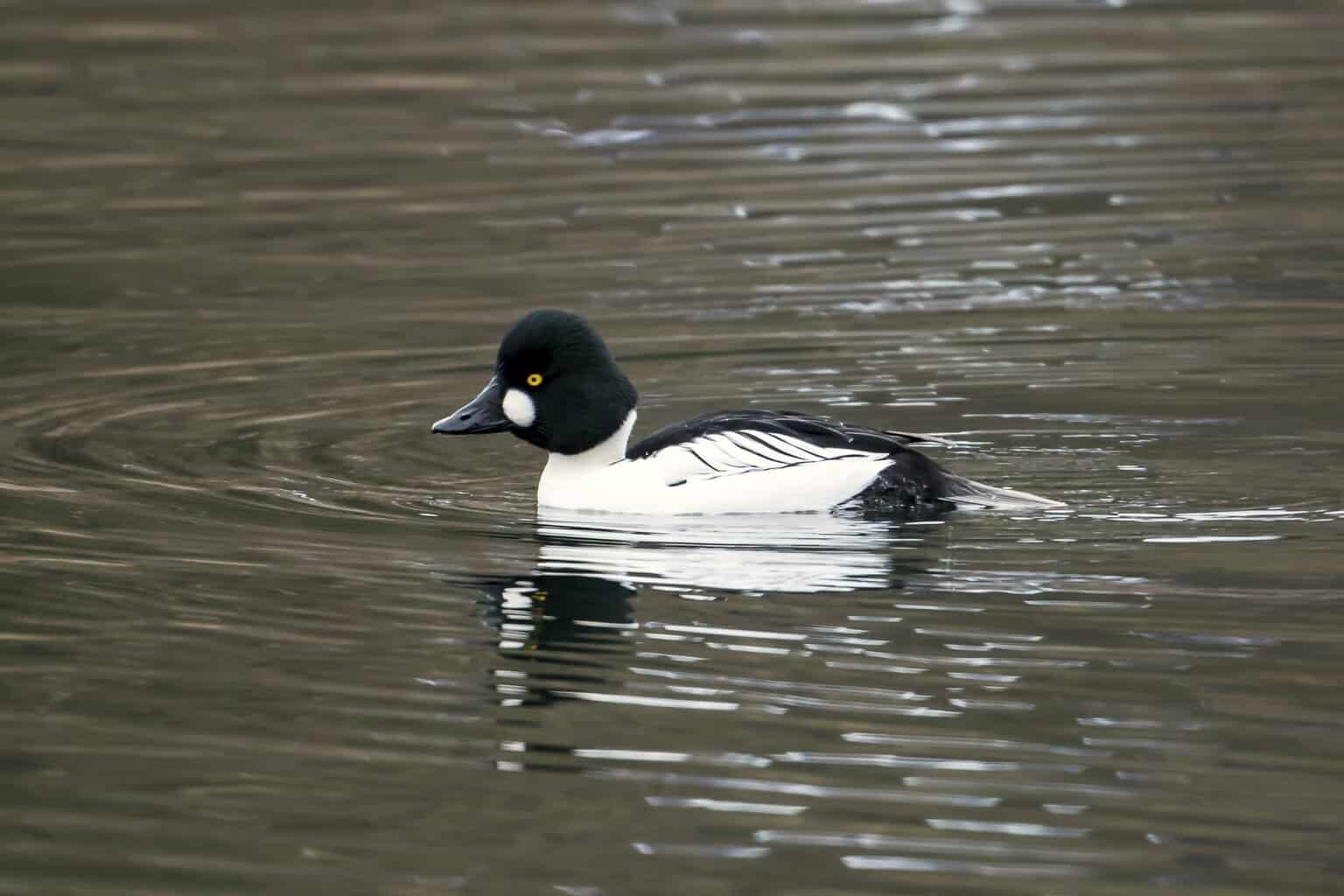
- Bucephala islandica
- Length: 16 – 20 in (41 – 51 cm)
- Weight: 38.4 oz (1088 g)
- Wingspan: 30 – 32 in (76 – 81 cm)
Barrow’s Goldeneyes have a fairly limited range, especially compared to more widespread ducks. They breed in southern Alaska, western Canada, and in a few small areas in eastern Canada. Then, for the winter, they move south along the Pacific Coast and throughout the Rocky Mountains.
Their winter habitat includes the length of California’s Pacific Coast, but they rarely go inland.
In the mountains, they inhabit lakes and ponds and build their nests in abandoned tree cavities, especially those left behind by woodpeckers. They will also build their nests in rocky cliffs or in trees. They are also willing to use nesting boxes.
Barrow’s Goldeneyes are closely related to Common Goldeneyes. Male Barrow’s have a dark purple head that may appear black if you see the duck from a distance. They have a white, crescent-shaped cheek patch behind their bill.
Females are gray-bodied with a dark brown head. The female has a yellowish-orange bill. She also has a white neck collar.
Barrow’s Goldeneyes avoid any bodies of water that have insect-eating fish. They don’t want to have to compete with the fish for their food!
Black Scoter (Sea Duck)
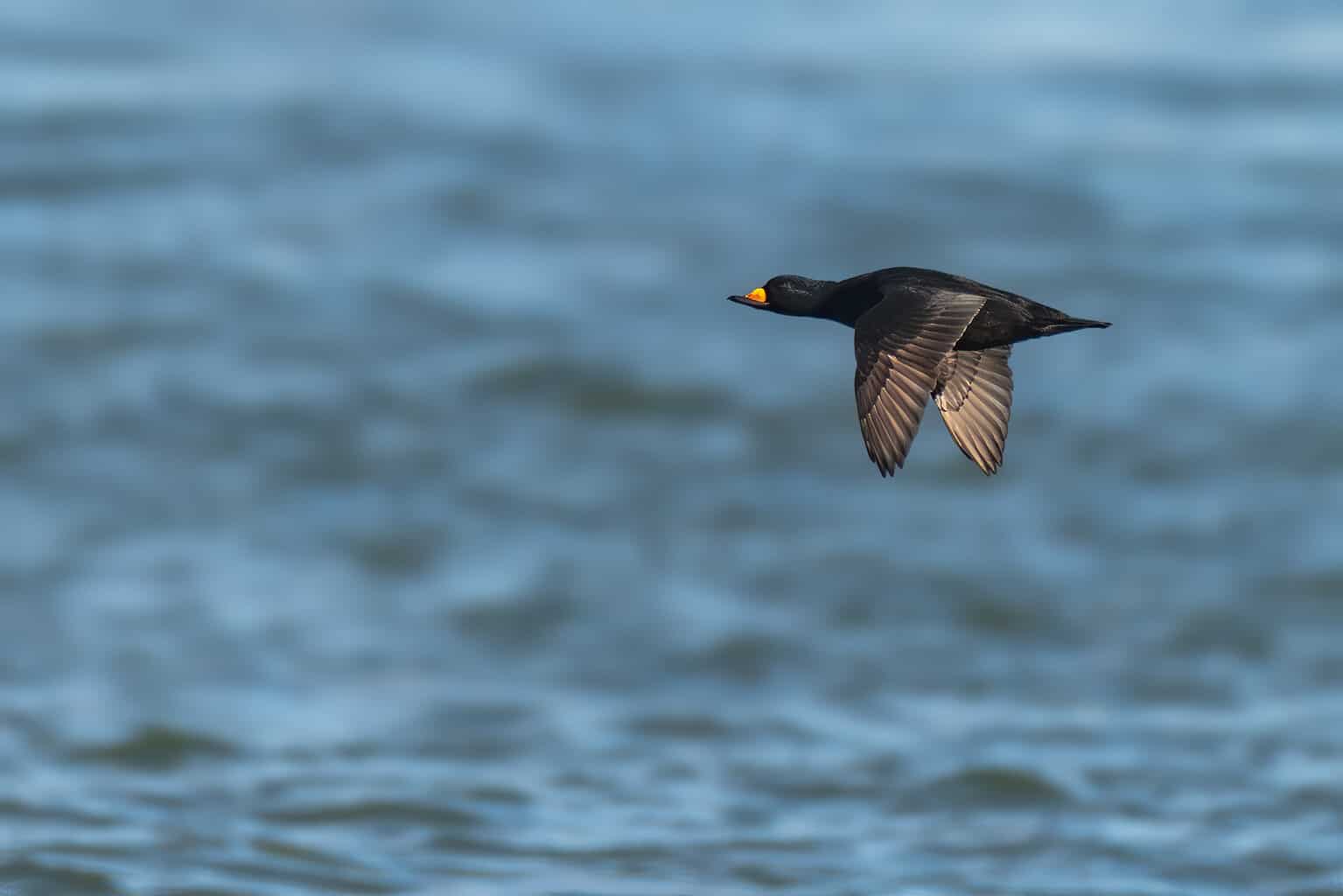
- Melanitta Americana
- Length: 127 – 21 in (43 – 53 cm)
- Weight: 387.4 oz (1088 g)
- Wingspan: 30 – 35 in (76 – 89 cm)
Black Scoters will not be found inland in California. However, during the winter, they will spend time on the Pacific Coast, all the way from Canada to Mexico. Their breeding territory is limited to northern Alaska and Quebec in Canada.
Male Black Scoters are black, but the base of their bill is shaped like a pumpkin-colored bulb. The female Black Scoter is brown with a darker crown and an all-black bill. While Black Scoters are medium-sized when compared to other ducks, they are the smallest of the sea-dwelling scoters.
Black Scoters prefer rocky coastlines and will flock together in large groups of thousands of other Scoters. They eat shellfish and mollusks, fish eggs, fish larvae, and aquatic vegetation.
Blue-Winged Teal Duck (Dabbling Duck)
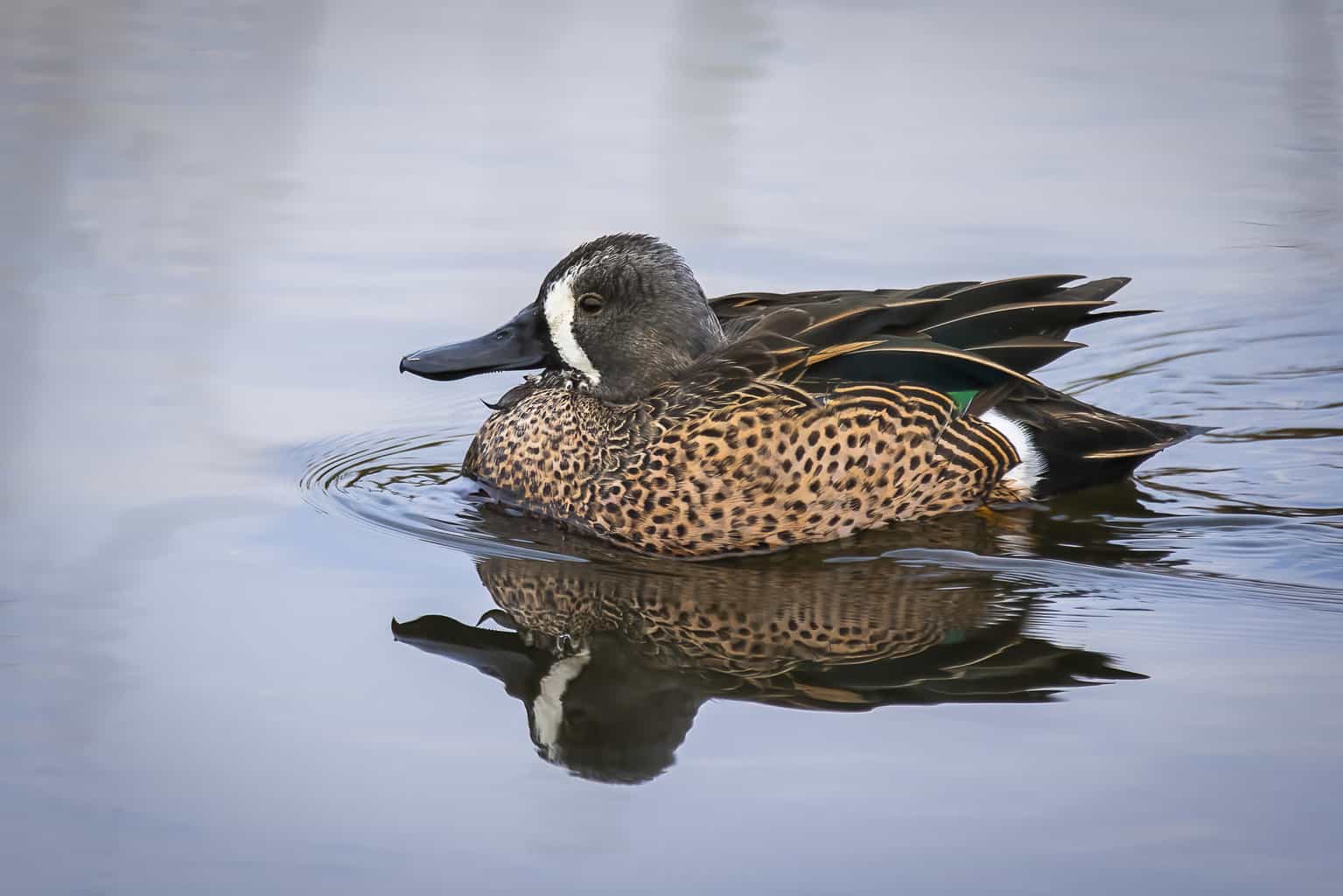
- Spatula discors
- Length: 15 – 17 in (38 – 43 cm)
- Weight: 19.18 oz (544 g)
- Wingspan: 23 -31 in (58 – 79 cm)
The Blue-Winged Teal Duck is widespread across most of the US during the summer, but the only place in California where you’ll see them during the breeding season is in the northeastern corner of the state, in the Shasta Cascades.
They mostly spend the winter in Mexico and Central America, but they also stretch along the Pacific Coast of California.
They are some of the first migrants to arrive in the fall, and some of the last to leave in the spring.
Male Blue-Winged Teal Ducks have blue-gray heads and a brown, spotted body. They have a white crescent shape in front of their eyes. The male’s shoulder patch is blue, and he has an iridescent green speculum.
Females are also spotted. They don’t have the white crescent on the face.
Blue-Winged Teal Ducks eat aquatic plants and insects. They have high mortality rates, likely related to their small size and long migration. Unlike the ducks in this list who are happy to live in rough, rocky waves, Blue-Winged Teals prefer much calmer waters.
Bufflehead (Diving Duck)
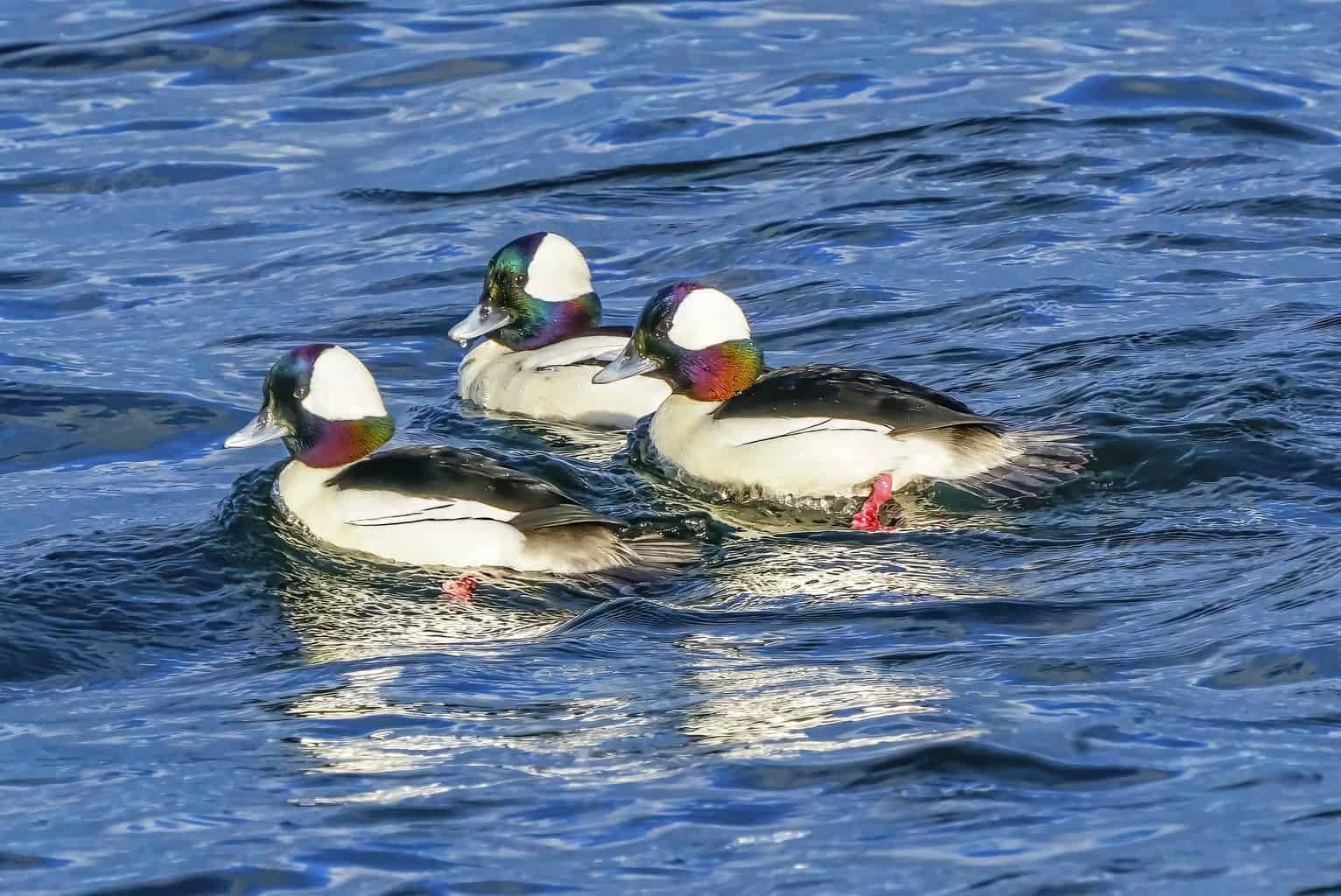
- Bucephala albeola
- Length: 13 – 16 in (33 – 41 cm)
- Weight: 21.16 oz (600 g)
- Wingspan: 20 – 24 in (51-61 cm)
Buffleheads are incredibly widespread throughout North America. They only breed in a few small areas in Canada and Alaska, but they spread throughout most of the US and parts of Mexico.
That includes California, where Buffleheads are found throughout the state during the winter. There is also a small part of the Shasta Cascades where Buffleheads actually stay put year-round. They inhabit small ponds, inland lakes, and forested waterways.
Buffleheads have a fluffy, round head (which gives them their name). The male Bufflehead’s head is iridescent green, iridescent purple, and bright white. His body is mostly white, but his back is black.
The female Bufflehead has a dark brown head with a white patch beneath her eyes. She has a gray and black body.
Buffleheads are cavity dwellers who are especially prone to using nesting boxes.
Canvasback (Diving Duck)
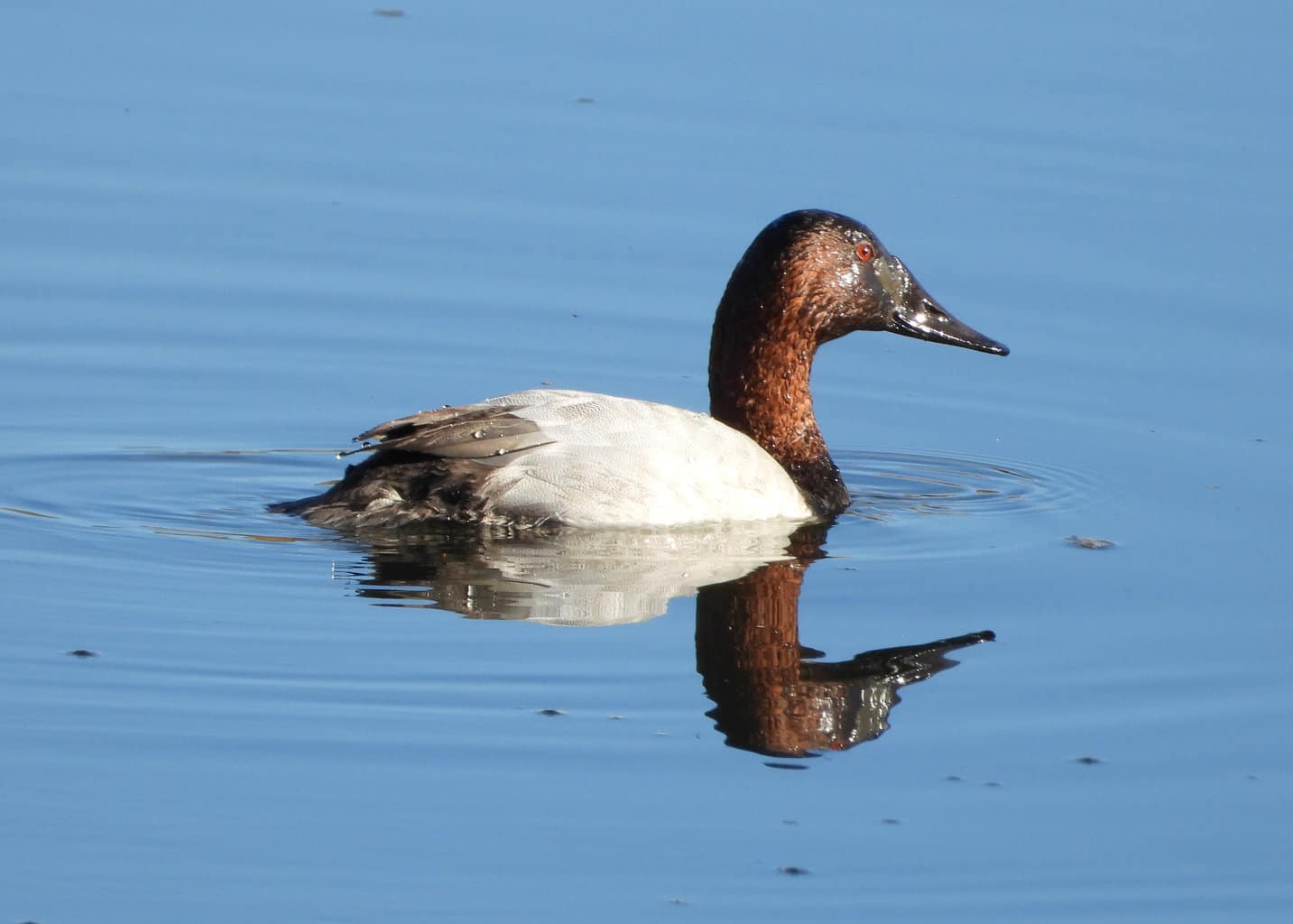
- Aythya valisineria
- Length: 19 – 24 in (48 – 61 cm)
- Weight: 58.48 oz (1657 g)
- Wingspan: 28 – 36 in (71 – 91 cm)
Canvasbacks avoid the desert, but otherwise, they live throughout California during the winter. Their breeding territory also extends into the Shasta Cascades.
Male Canvasbacks boast a rich, copper-y head and a black chest. The rest of his body is light gray. Females have a similar pattern, but with much more muted coloring. The female’s eyes are dark black, and the male’s eyes are red.
They arrive in October and stick around until around April. From November to March, they are especially common in the Central Valley.
Cinnamon Teal Duck (Dabbling Duck)
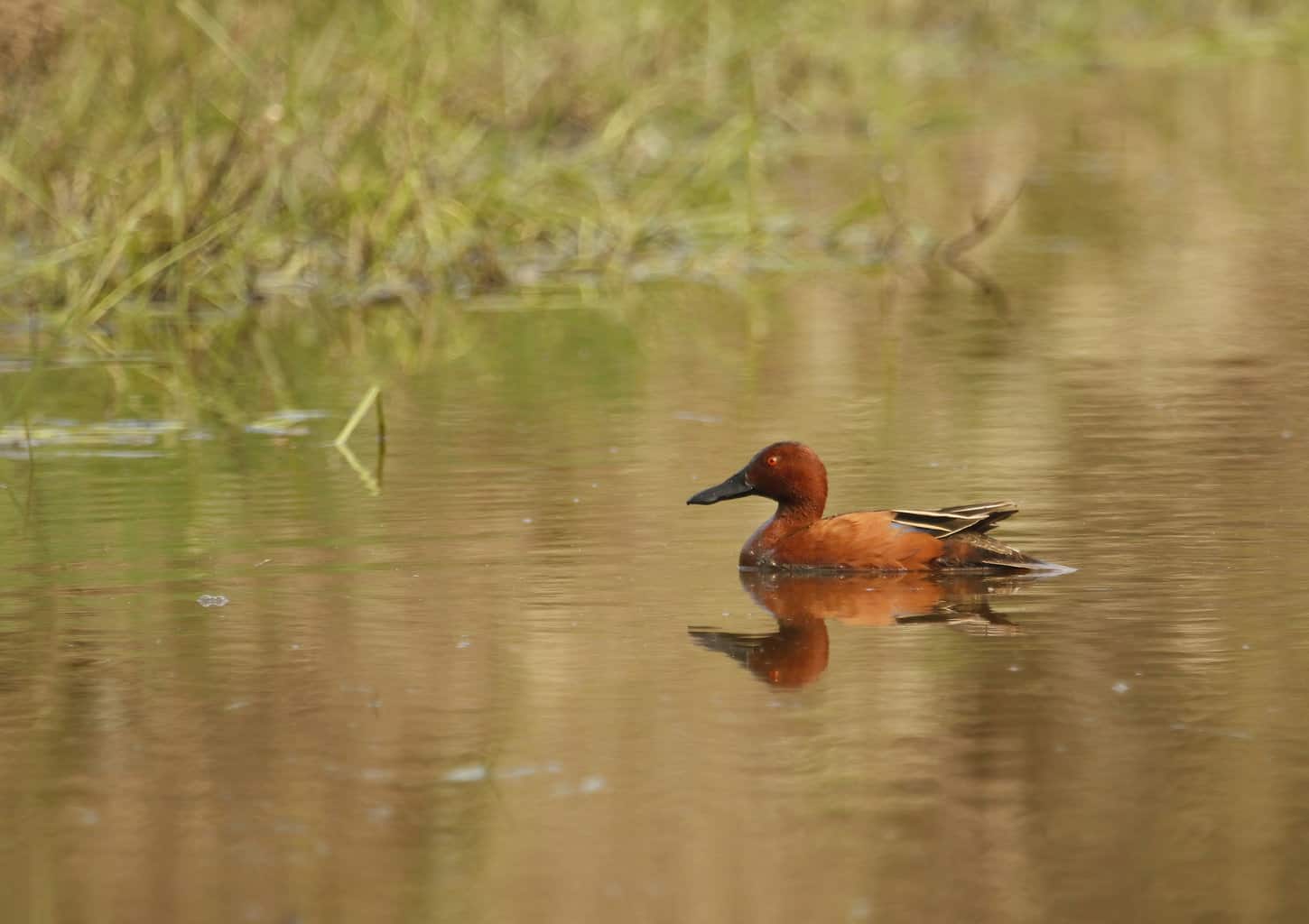
- Spatula cyanoptera
- Length: 14- 17 in (36 – 43 cm)
- Weight: 16.4 oz (465 g)
- Wingspan: 24 – 30 in (61 -76 cm)
Cinnamon Teal Ducks live along the California coastline year-round. They are found in the rest of the state during the breeding season, where they nest with a new partner every year.
Cinnamon Teal Ducks are especially colorful during the breeding season. Males are reddish-orange with red eyes, a pale blue shoulder, and an iridescent green speculum.
Females and non-breeding males have a scaled pattern in light and dark across most of their body.
Their diet mostly consists of plants, including: bulrush, smartweed, wigeon grass, millet, horned pondweed, and spikerush. They will also eat living creatures: snails, beetles, water fleas, flies, etc.
Common Goldeneye (Sea Duck)
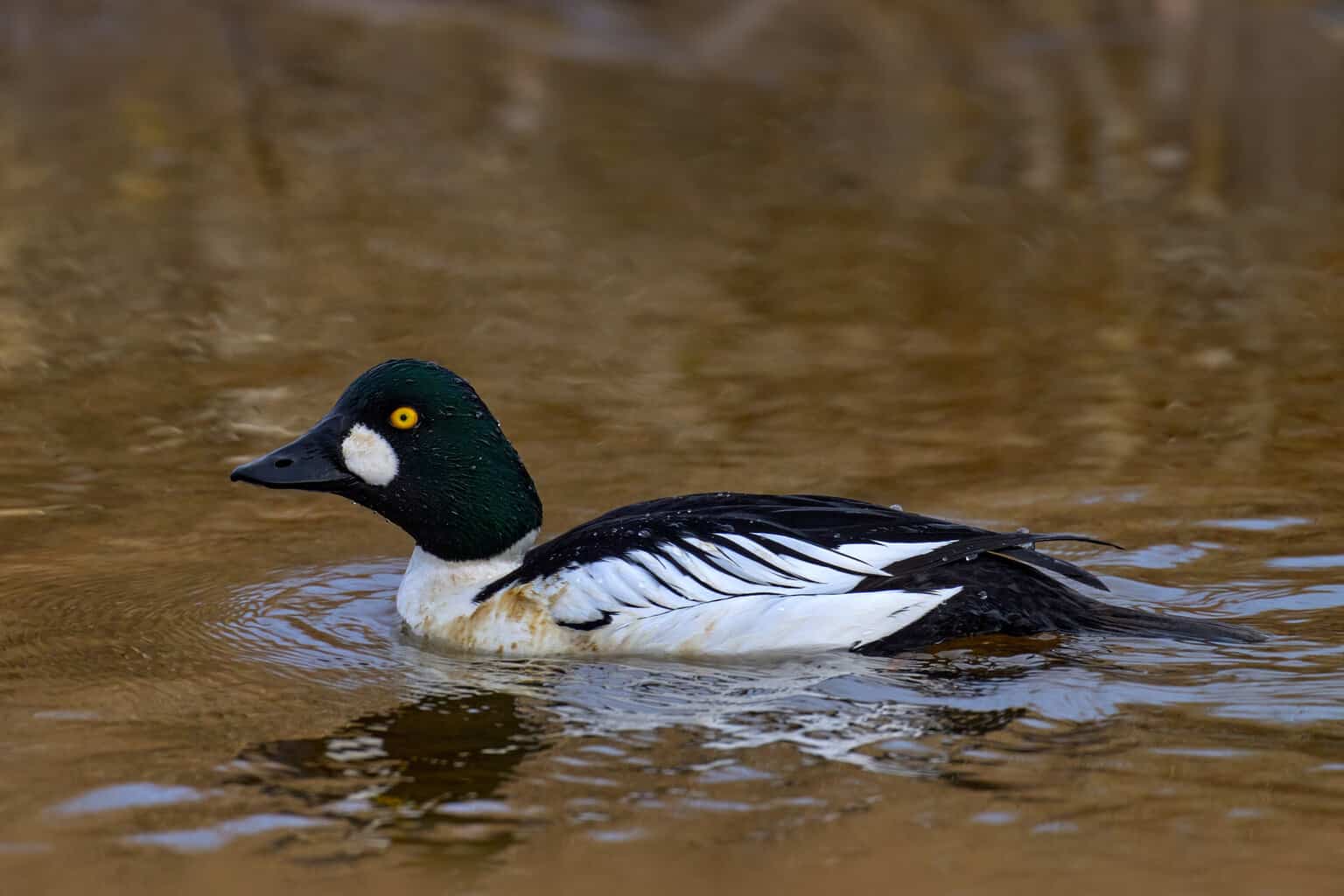
- Bucephala clangula
- Length: 16-20 inches
- Weight: Approximately 1.8 pounds
- Wingspan: 30.3-32.7 inches
Common Goldeneyes are common winter residents in California, widespread throughout the entire state except for a very small portion of Southern California, near the Mexico border.
The Common Goldeneye male has a black and white body and an iridescent green head. He has white patches on his wings, a black bill, and a bright, golden-yellow eye. The female’s body is brown, and she has a yellow-tipped black bill.
These are aggressive ducks who will sometimes fight each other. Females will get into a conflict over territory, which leads to their ducklings being scattered about. They will then join a new family – whichever nest they can find their way to!
Common Merganser (Diving Duck)
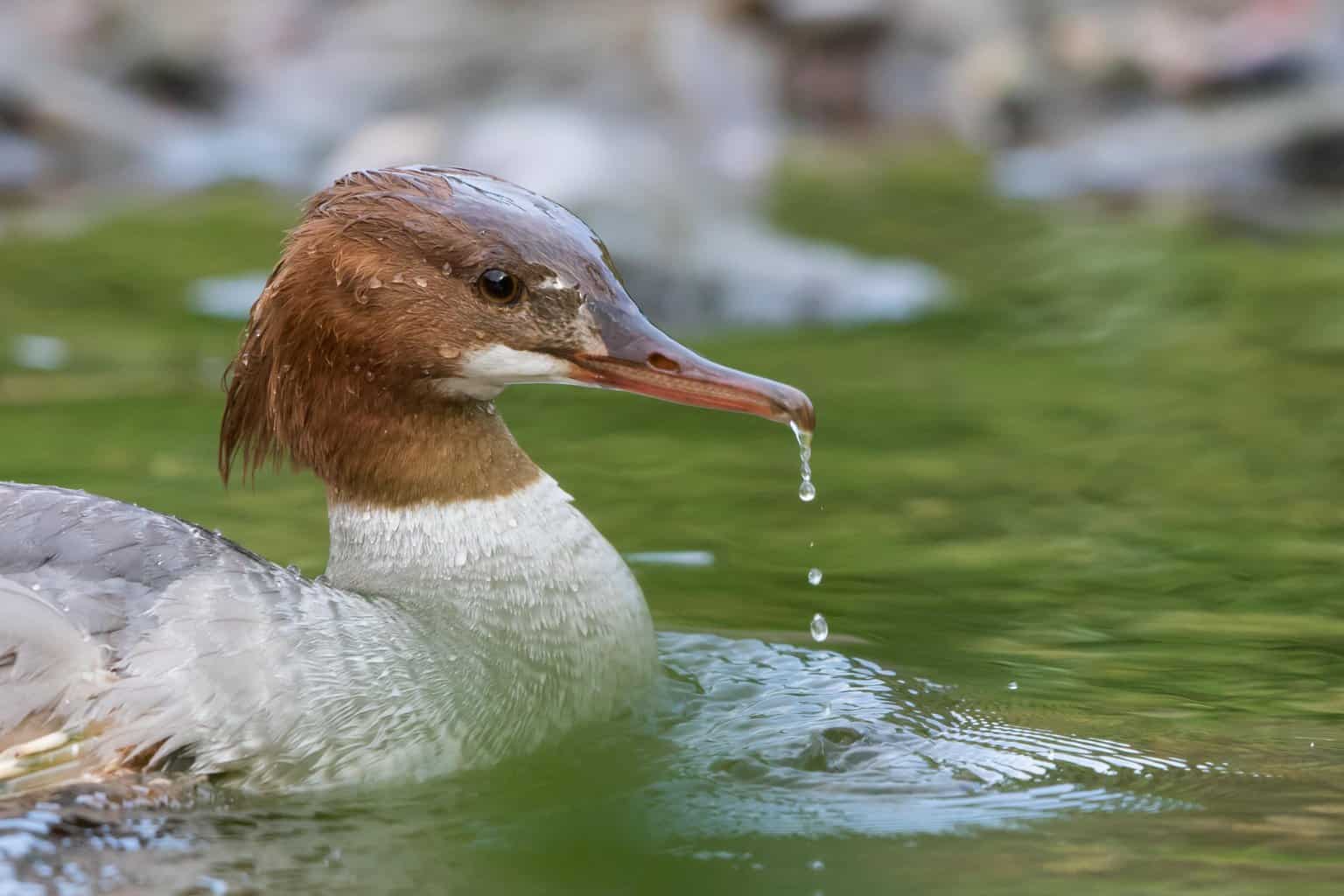
- Mergus merganser
- Length: 22 – 27 in (56 – 69 cm)
- Weight: 60.8 oz (1723 g)
- Wingspan: 31 – 37 in (79 – 94 cm)
Common Mergansers are year-round residents of California’s Shasta Cascades and North Coast. They are migratory winter residents of the rest of the state.
The male Common Merganser has a bright red bill, a sometimes-visible crest, and a dark green head with black eyes. The female’s crest is much more visible in cinnamon-red, like her head. She also has a white chin patch, a gray back, and a white belly and breast.
Male and female Mergansers have a shared trait with other mergansers: a long, serrated bill. This allows them to rip apart the fish that make up a large portion of their diet.
Although they are cavity dwellers, they will accept human-made nesting boxes. They prefer mature forests and freshwater ponds, lakes, and small rivers.
Eurasian Wigeon (Dabbling Duck)
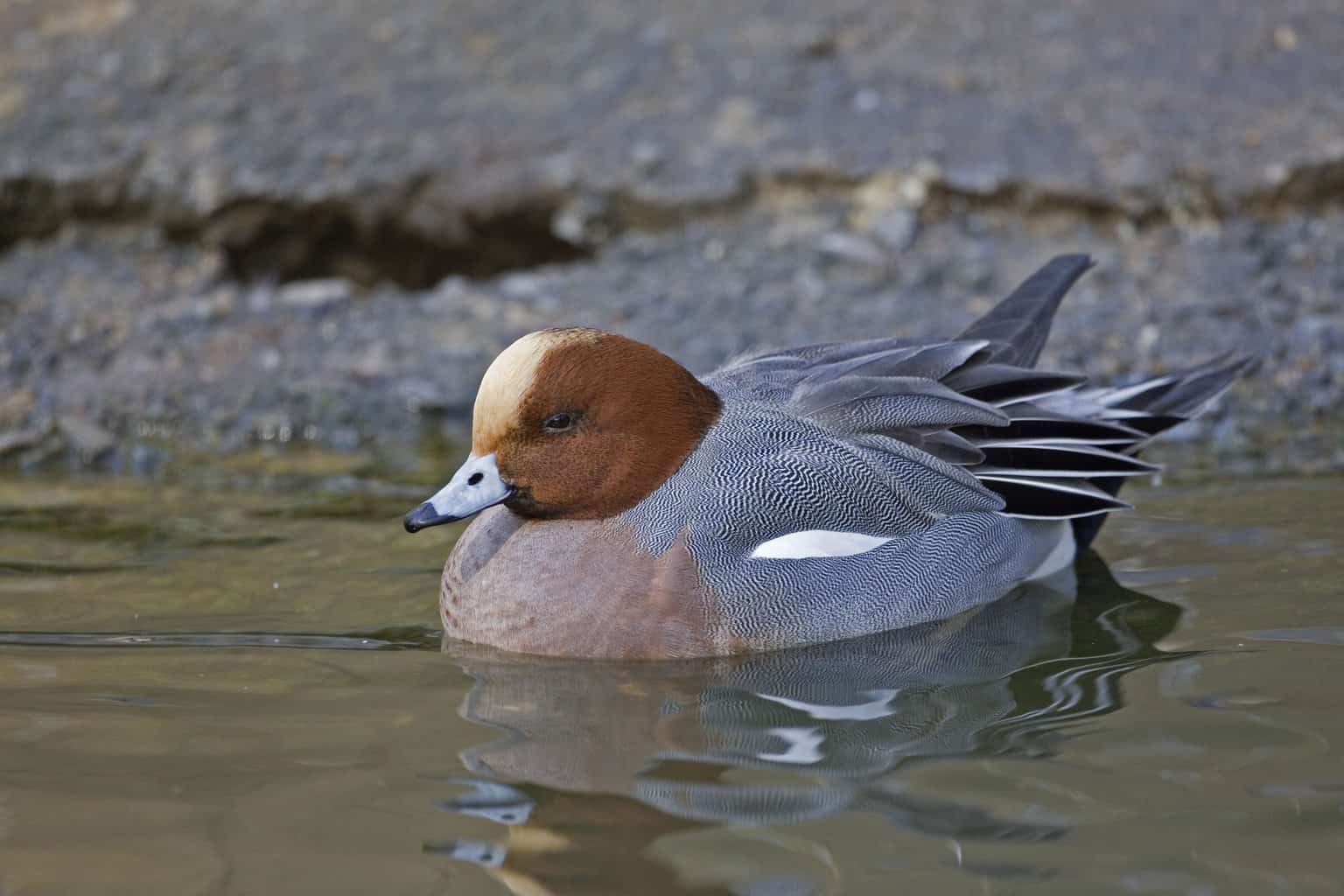
- Mareca penelope
- Length: 18 – 20 in (46 – 51 cm)
- Weight: 35.27 oz (1000 g)
- Wingspan: 30 – 32 (76 – 81 cm)
Eurasian Wigeons are primarily found in Northern Europe and across Russia. If they are seen in the US, they may be accidental vagrants, or they may be one of the small populations that migrate to North America for the winter.
One of these populations is found in San Francisco Bay.
Male Eurasian Wigeons are covered with small black and white bills. The male’s bill is blue with a black tip, and he has coppery brown head with a creamy white face patch. Females are brown or gray, with a speckled brown head.
They are very good at stealing food from nearby ducks, waiting for them to surface with their prey or foraged food. That is their ideal moment to swoop in and steal their favorite food.
Eurasian Wigeons do not nest in North America, so we will not see the nests they build on the ground, hidden by tall grasses.
Gadwall (Dabbling Duck)
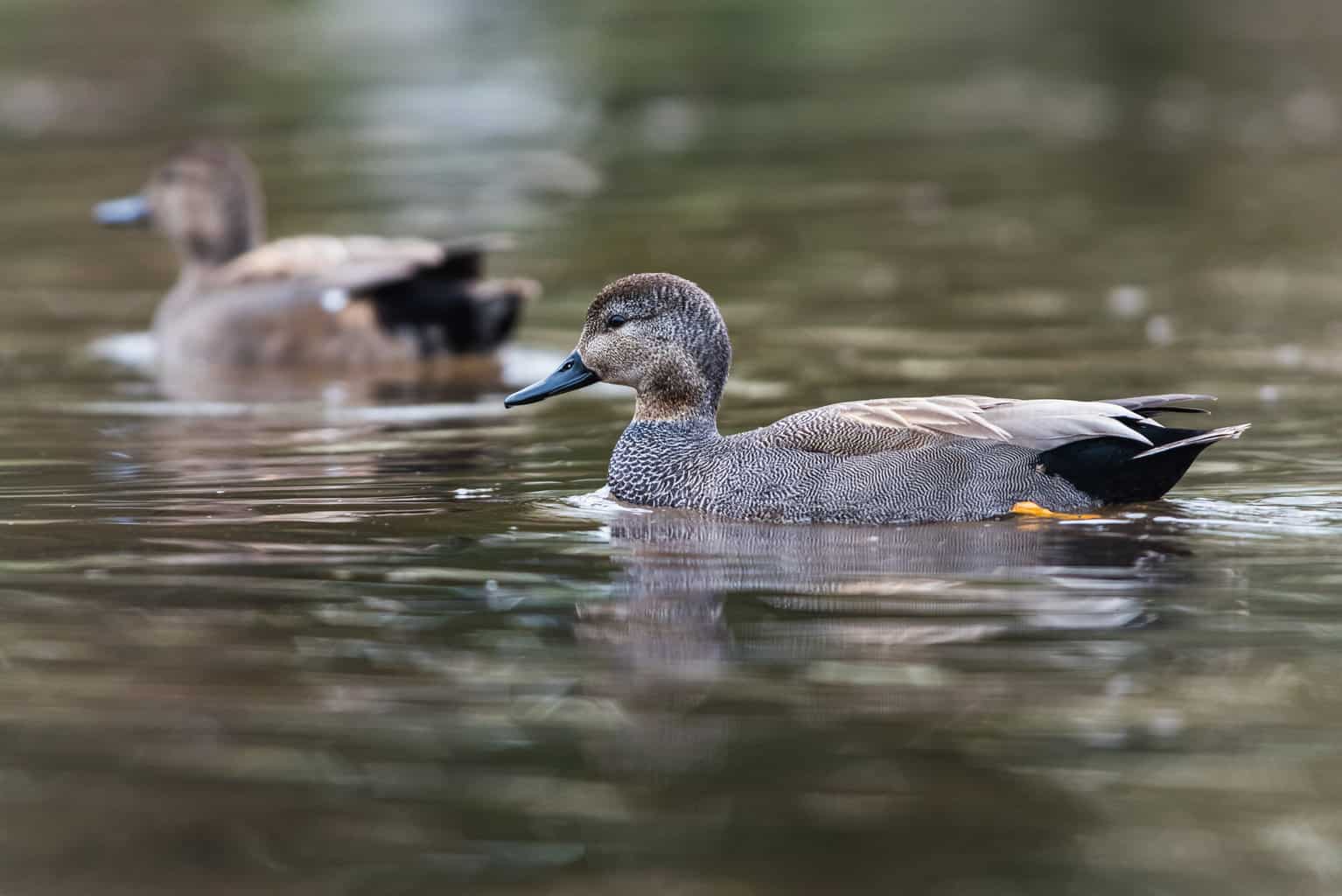
- Mareca strepera
- Length: 19 – 23 in (48 – 58 cm)
- Weight: 35.27 oz (1000 g)
- Wingspan: 31 – 36 in (79 – 91 cm)
In most of California, Gadwall are year-round residents. In the Central Valley, they are winter inhabitants.
They are very commonplace and sometimes can be easy to miss. Males are more muted than females, with a light brown and white body. Females are dark brown with off-white markings.
Gadwall tend to live in open wetlands, including flooded areas, like grasslands and marshes. In the winter, they will also live along saltwater marshes and in city parks.
These are some of the most effective camouflagers in the world of ducks! Their plain coloring and ability to hide among tall grasses makes them a bit harder to spot. If they want to stay hidden, they will!
Greater Scaup (Diving Duck)
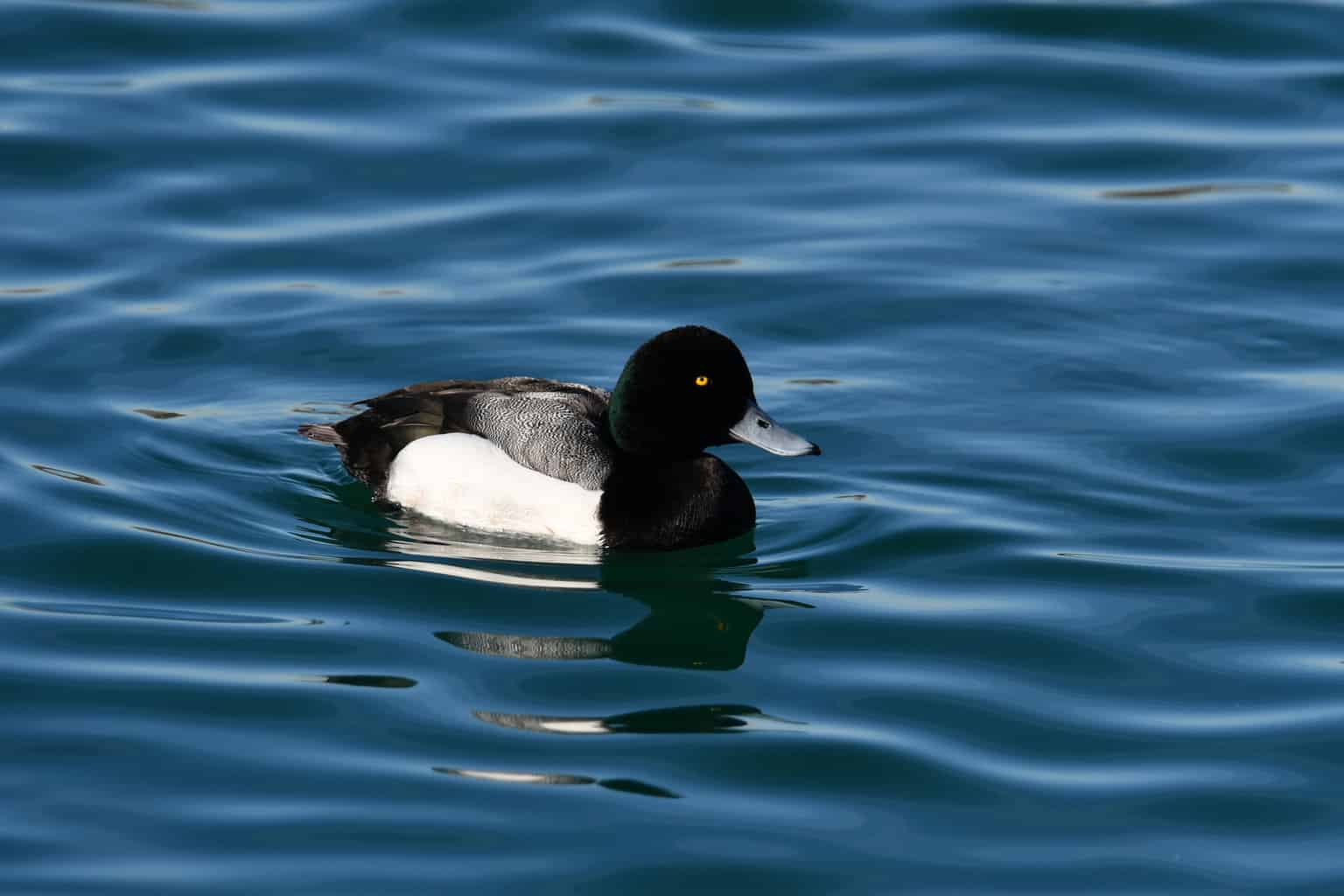
- Aythya marila
- Length: 15.3 – 22.1 in (39 – 56 cm)
- Weight: 25.6 – 48.0 oz (726 – 1360 g)
- Wingspan: 28.4 – 31.1 in (72 – 79 cm)
Greater Scaup spend the winter across most of California, but they avoid the northeastern corner and the eastern edge of the Desert region. In the winter, they flock to saltwater bays, estuaries, and large freshwater lakes.
In the breeding season, the male Greater Scaup has a back that is barred in gray and black. He has an iridescent green head, a blue bill, and white sides. In the winter, his head loses its iridescent sheen, and his colors fade to gray and brown.
The female has a brown body with a dark head. She also has a white face patch.
Greater Scaup will dive up to 23 feet under the surface to pursue prey or forage for food. They eat a lot of mollusks and insects, but they also eat plants and seeds. If they share space with too many boats during the day, they will forage at night instead.
Green-Winged Teal Duck (Dabbling Duck)
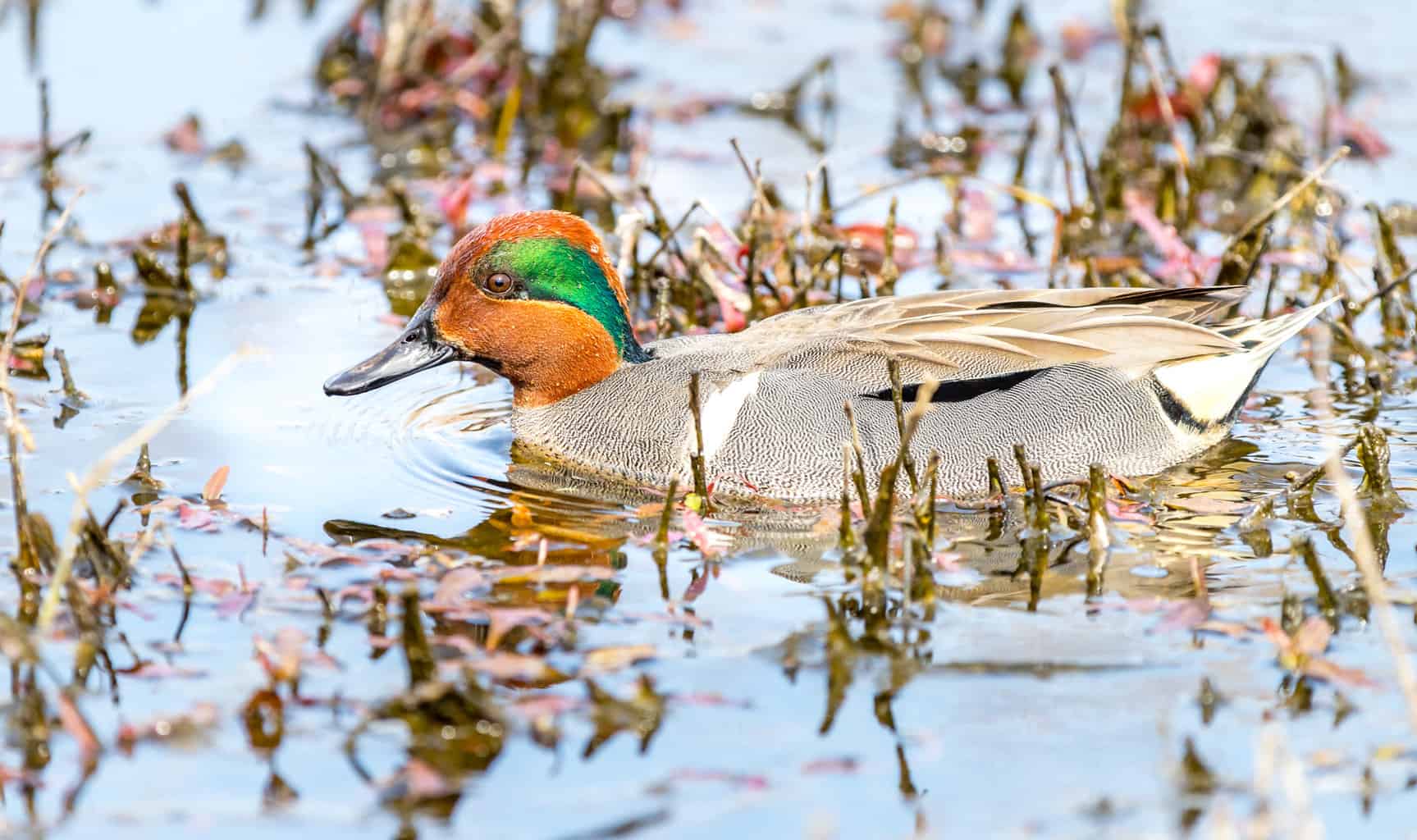
- Anas crecca
- Length: 12.2 – 15.3 in (31 – 39 cm)
- Weight: 4.9 – 17.6 oz (140 – 500 g)
- Wingspan: 20.5 – 23.2 in (52 – 59 cm)
For the most part, Green-Winged Teal Ducks are winter residents of California. Some populations will stay in the Shasta Cascades and on the North Coast for the entire year. The best way to see them in the winter is along coastal bays and estuaries or in shallow inland lakes and ponds.
Like other teal ducks, Green-Winged Teal Ducks are small. The male has a green stripe across his eyes to the back of his head. The rest of his head is cinnamon brown, and his body is barred in gray and white. Females are brown-bodied with a yellow streak along their tails.
Males and females alike have an iridescent green speculum.
Green-Winged Teals are one of the ducks that can take off directly from the water, without any need for a running start,
Harlequin (Sea Duck)
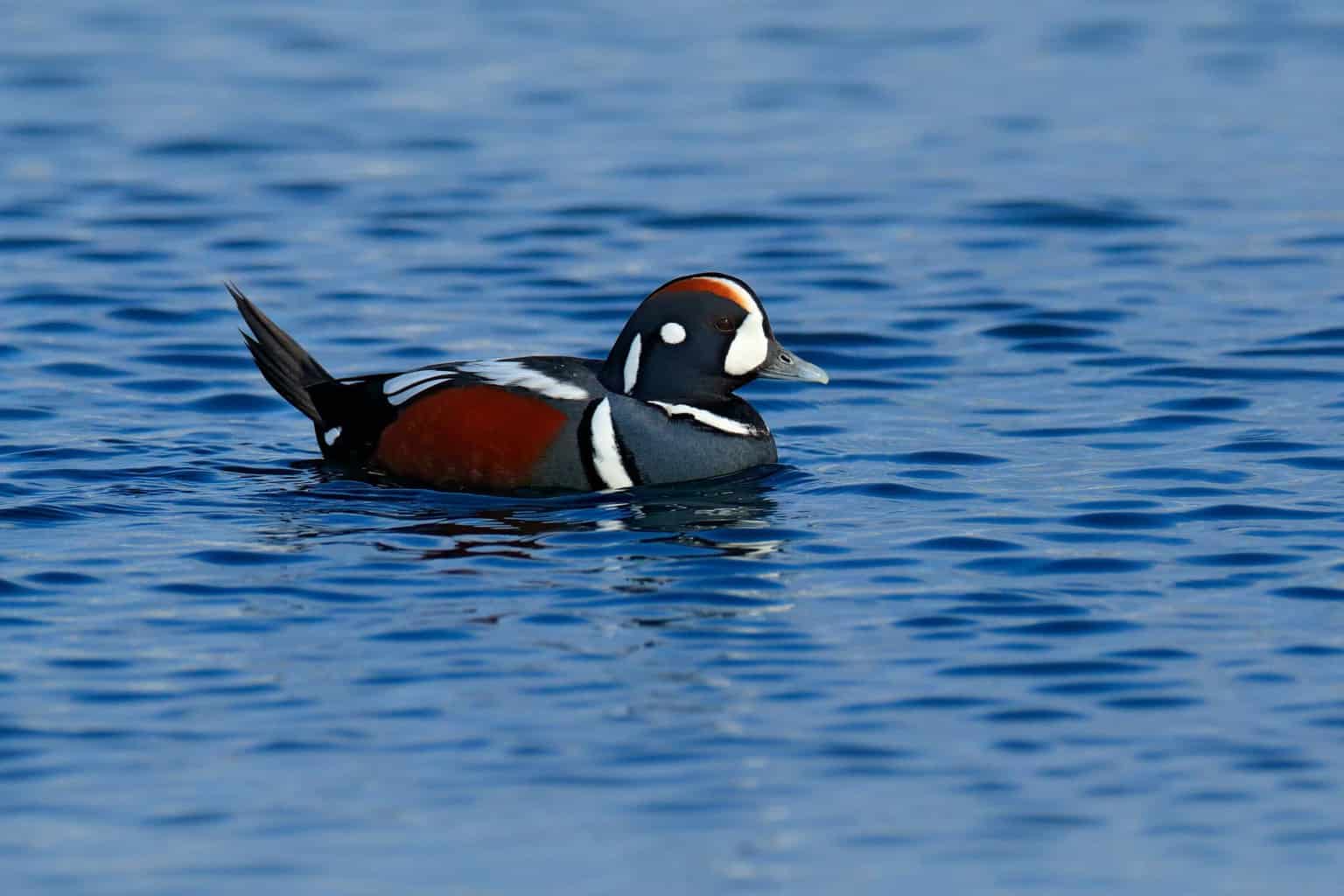
- Histrionicus histrionicus
- Length: 15 – 21 in (38 – 53 cm)
- Weight: 24 oz (680 g)
- Wingspan: 26 – 28 in (66 – 71 cm)
The winter range of the little Harlequin Duck extends along the Pacific Coast from Alaska to the very northern edge of California. They are great swimmers, and they live in rough, turbulent waters. They don’t seem to mind the huge waves that smash them into the rocky edges of the water — and yet researchers have found evidence that their bones are often broken by these rough waters.
Male Harlequin Ducks are especially colorful in the breeding season. That’s when they are slate blue with contrasting, black-outlined white stripes on their heads, chests, and necks. They have areas of reddish-brown all over their bodies.
Female Harlequins are brown with a small white patch on the back of their heads.
Harlequins are nicknamed the Sea Mouse because of the mouse-like sound they make. It’s easy to remember, though, because they are also among the smallest ducks in North America.
Hooded Merganser (Sea Duck)
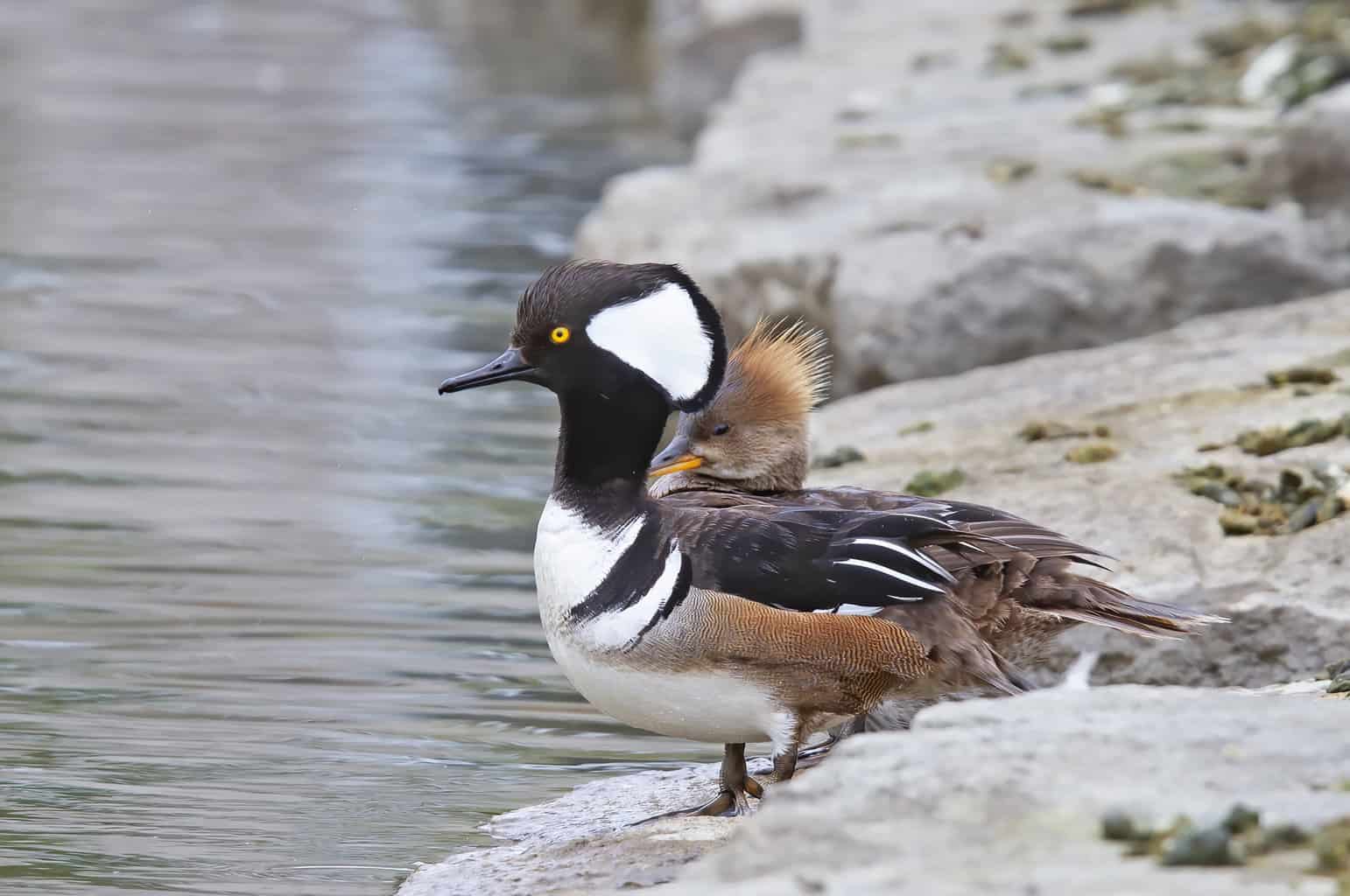
- Lophodytes cucullatus
- Length: 16 – 19 in (41 – 48 cm)
- Weight: 32.09 oz (909 g)
- Wingspan: 24 – 26 in (61 – 66 cm)
Hooded Mergansers avoid California’s deserts, but they spend the winter in much of the state, including the north, coastal region, and south. These little sea ducks live in large freshwater bodies during the winter, as well as sheltered saltwater bays and marshes.
They are the only type of merganser that doesn’t live on any other continent other than North America.
Male Hooded Mergansers have light brown coloring on their sides. The rest of their bodies are black and white, and their chests are barred in black. The male has a crest that he can raise and lower at will, creating either a flat-headed appearance or a tall, fan-shaped head. His crest is black and white.
Females are entirely brown, and their crest is a muted, muddy brown.
Because Hooded Mergansers sound like croaking pickerel frogs, they are called the Frog Duck.
The Frog Duck nests 20 feet above the ground, in abandoned tree cavities. Hooded Merganser ducklings leap from their safe, secure nest within 24 hours of their hatching and join their parents in foraging for food.
Lesser Scaup (Diving Duck)
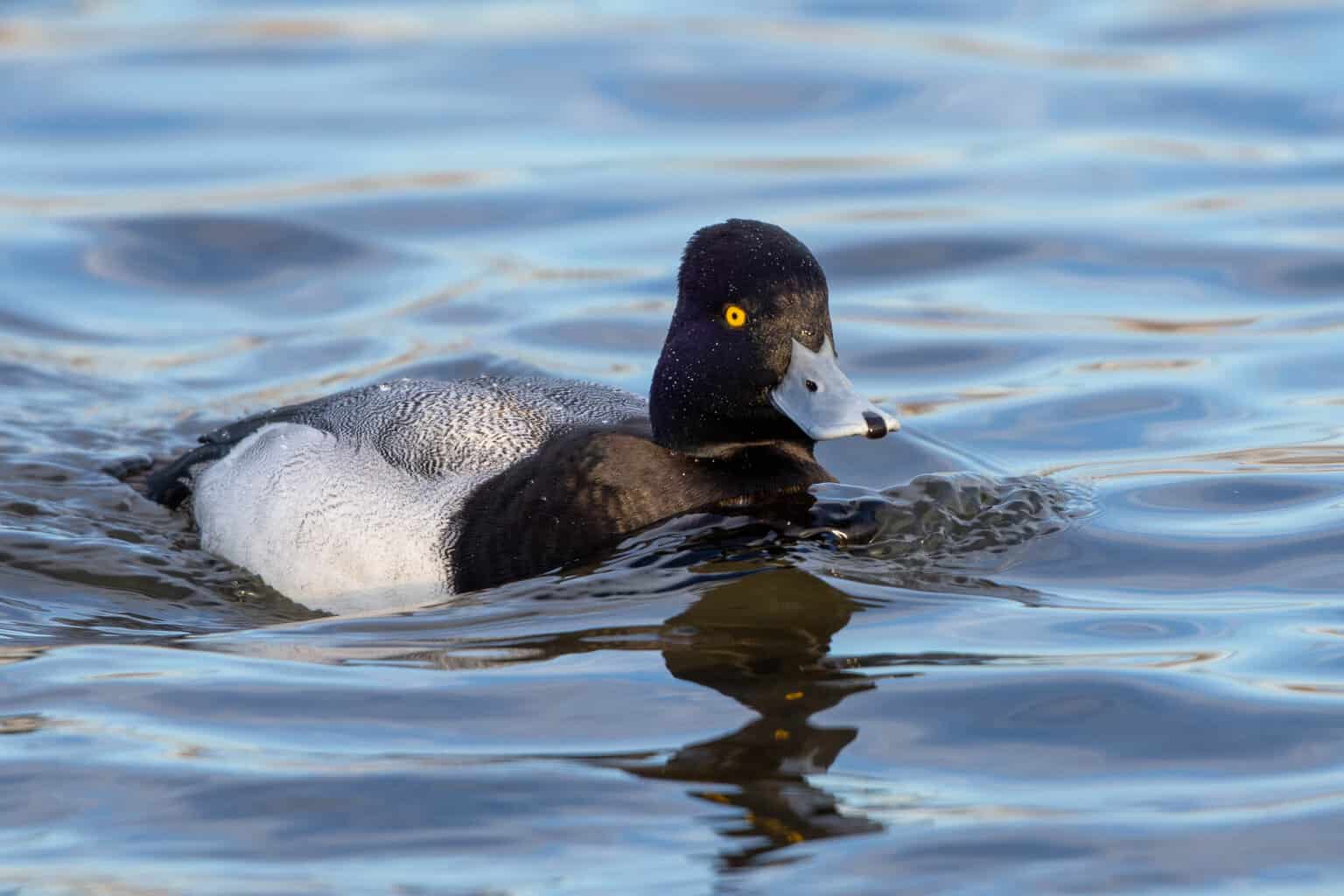
- Aythya affinis
- Length: 15 – 18 in (38 – 49 cm)
- Weight: 40.77 oz (1155 g)
- Wingspan: 24 – 33 in (61 – 84 cm)
Lesser Scaup are yet another Californian duck that will spend the whole year in the Shasta Cascade, but winter in the rest of the state. Their winter territory includes reservoirs, bays, estuaries, and lakes. Their close relative, the Greater Scaup, tends to avoid inland lakes, but Lesser Scaup are content to stay inland for the winter.
Their appearance is similar to Greater Scaup, with a few key differences. Lesser Scaup have a few stray “hairs” atop their heads, creating the appearance of a very small crest. Males have iridescent purple heads that are dark enough to look black from a distance. Their eyes are golden, their sides are white, and they have gray bars across the body.
Females are dark brown, and they have a white face patch.
Lesser Scaup will also play dead to avoid being attacked by predators. They also practice safety in numbers by gathering in large groups that number in the thousands.
Long-Tailed Duck (Diving Duck)
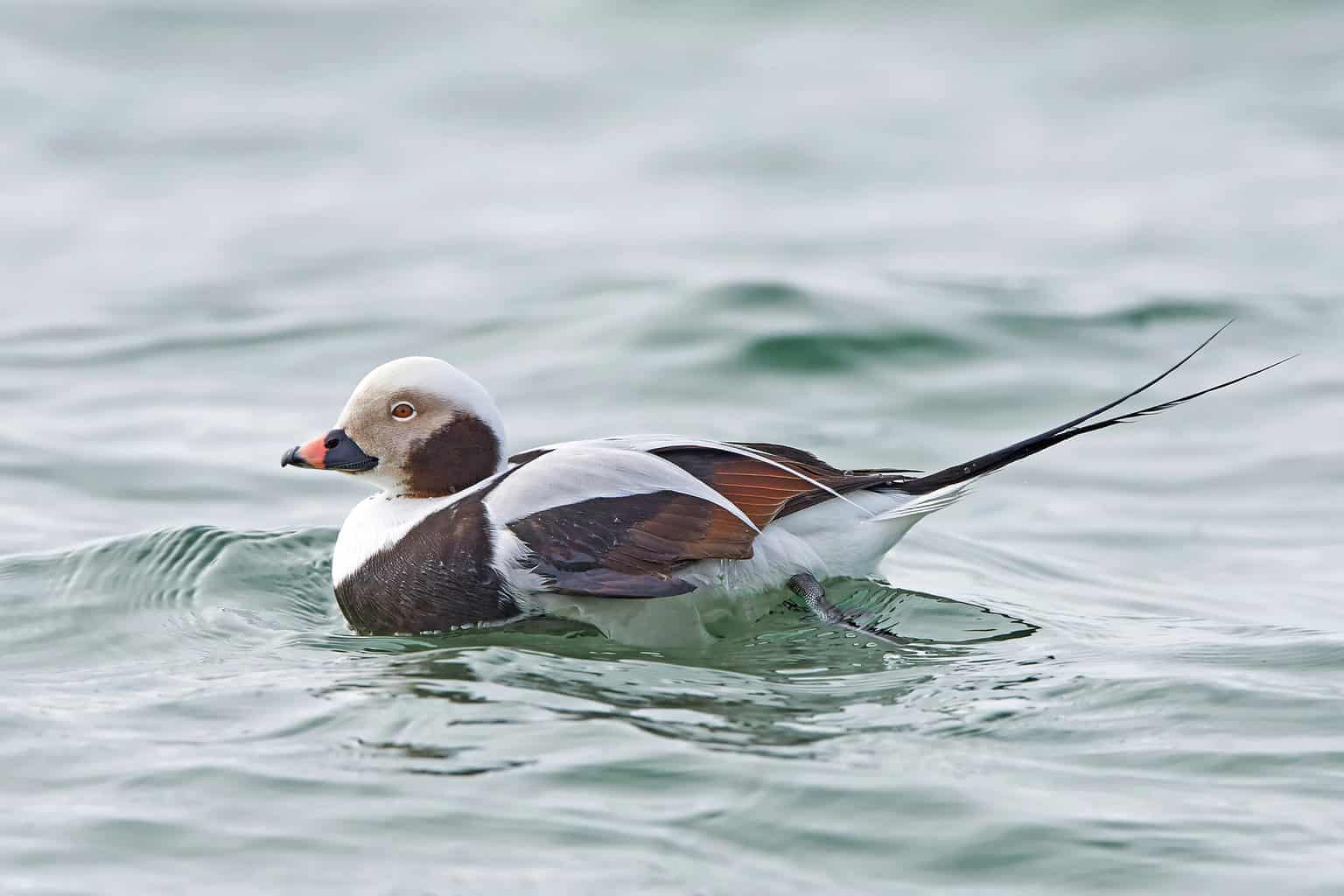
- Clangula hyemalis
- Length: 15 – 22 in (38 – 56 cm)
- Weight: 31.74 oz (900 g)
- Wingspan: 26 – 31 in (66 – 79 cm)
Long-Tailed Ducks are arctic ducks who winter along the far northern Atlantic and Pacific coasts. On occasion, a small number of Long-Tailed Ducks will be found along the Californian coast.
Long-Tailed Ducks are fascinating because of the way their colors change. Although plenty of ducks lose their vibrant coloring in the winter, Long-Tailed Ducks may be the only duck that completely reverses its coloring.
During the winter, the Long-Tailed Duck male is mostly white; his crown, forehead, back, neck, shoulders, sides, and undersides are all white. He has a gray eye mask, a dark black patch on his cheek, a black breast, and black wings. He also has a long black tail.
During the breeding season, everything switches. All the white areas become black, and all the black areas become white.
Females do the same thing! The female’s brown throat, back, tail, and wings turn white for the breeding season, and her white head changes to dark brown.
Long-Tailed Ducks are impressive due to their ability to dive deep underwater. Sometimes, they will dive as deep as 200 feet, chasing zooplankton.
Mallard (Dabbling Duck)
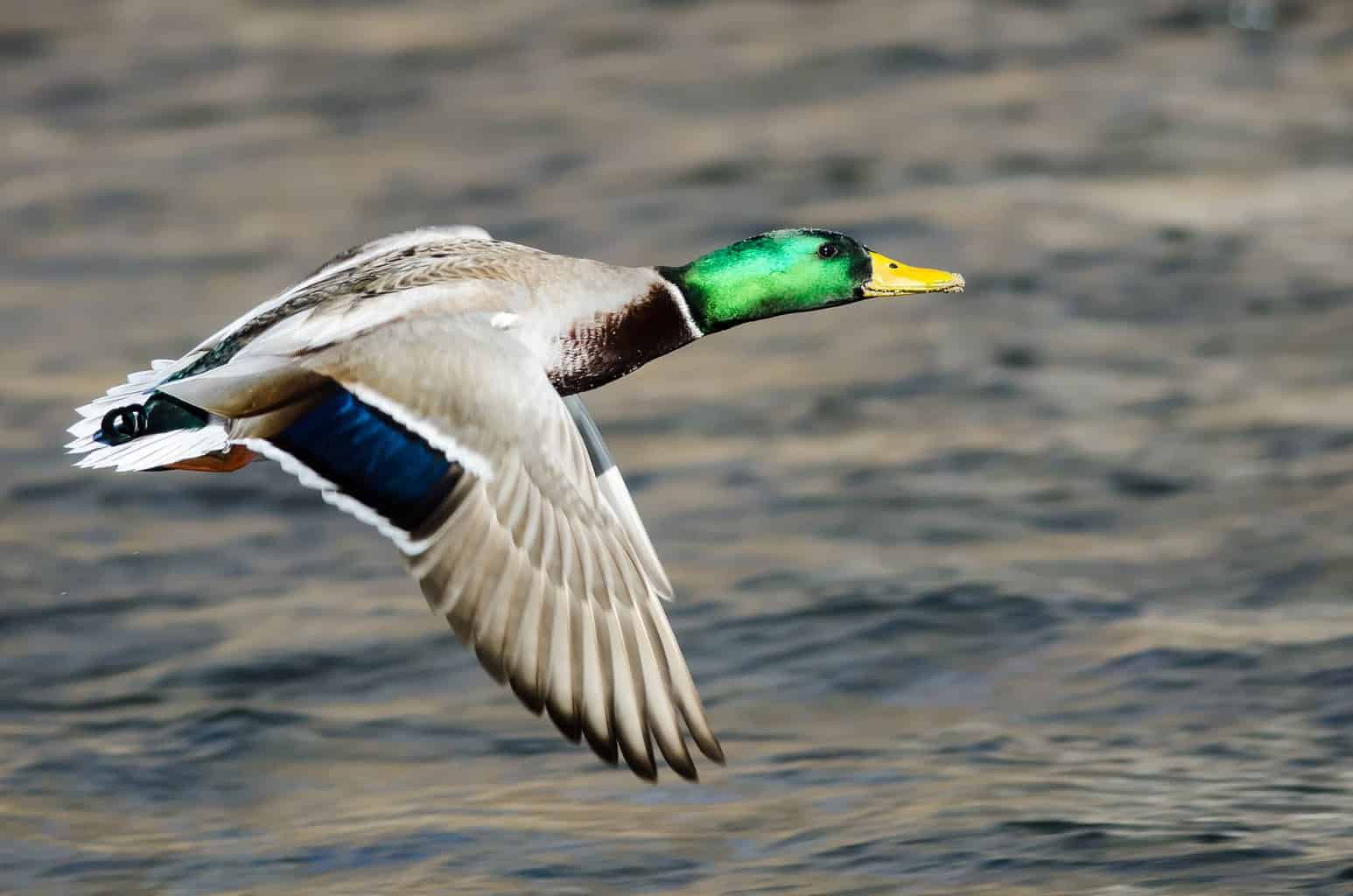
- Anas platyrhynchos
- Length: 19.7 – 25.6 in (50 – 65 cm)
- Weight: 35.3 – 45.9 oz (1000 – 1300 g)
- Wingspan: 32.3 – 37.4 in (82 – 95 cm)
Mallards are California’s most plentiful duck. Mallards are widespread throughout the northern hemisphere, and they are year-round residents of California.
You can easily recognize the male Mallard by his iridescent green head, thin white collar, brown breast, and gray sides. His bill is bright yellow, and his speculum is powder blue.
Females are light brown, with dark brown speckling and streaking.
Mallards are also easy to recognize because they are so commonly represented in any duck-themed art, home decor, and more.
Mallards are aggressive toward one another and other ducks, especially during the breeding season. Males are aggressive toward females and can make birders uncomfortable with their sexual behaviors toward females.
They prefer freshwater sources all year. In the summer, that typically includes swamps, wooded lakes, ponds, agricultural fields, marshes, city parks, and lakes. During the winter, you’re most likely to find them in California’s protected bays and estuaries.
Mandarin Duck (Dabbling Duck)

- Aix galericulata
- Length: 16 – 19 in (41 – 49 cm)
- Weight: 17.7 – 20 oz (444 – 500 g)
- Winsgpan: 25.5 – 29 in (65 – 75 cm)
Mandarin Ducks are rare in California, to the point that sightings often make the news.
Mandarin Ducks are stunning, sometimes described as being among the most beautiful ducks in the world. Males are multi-colored: orange, purple, blue, white, yellow, green, and black. He has “sail fins” on his back and a little pale-tipped red bill.
Female Mandarins are brown, dapple-chested, and have a shaggy head. They have a white eyering and a thin white line that runs from the eyes to the back of the head.
Northern Pintail (Dabbling Duck)
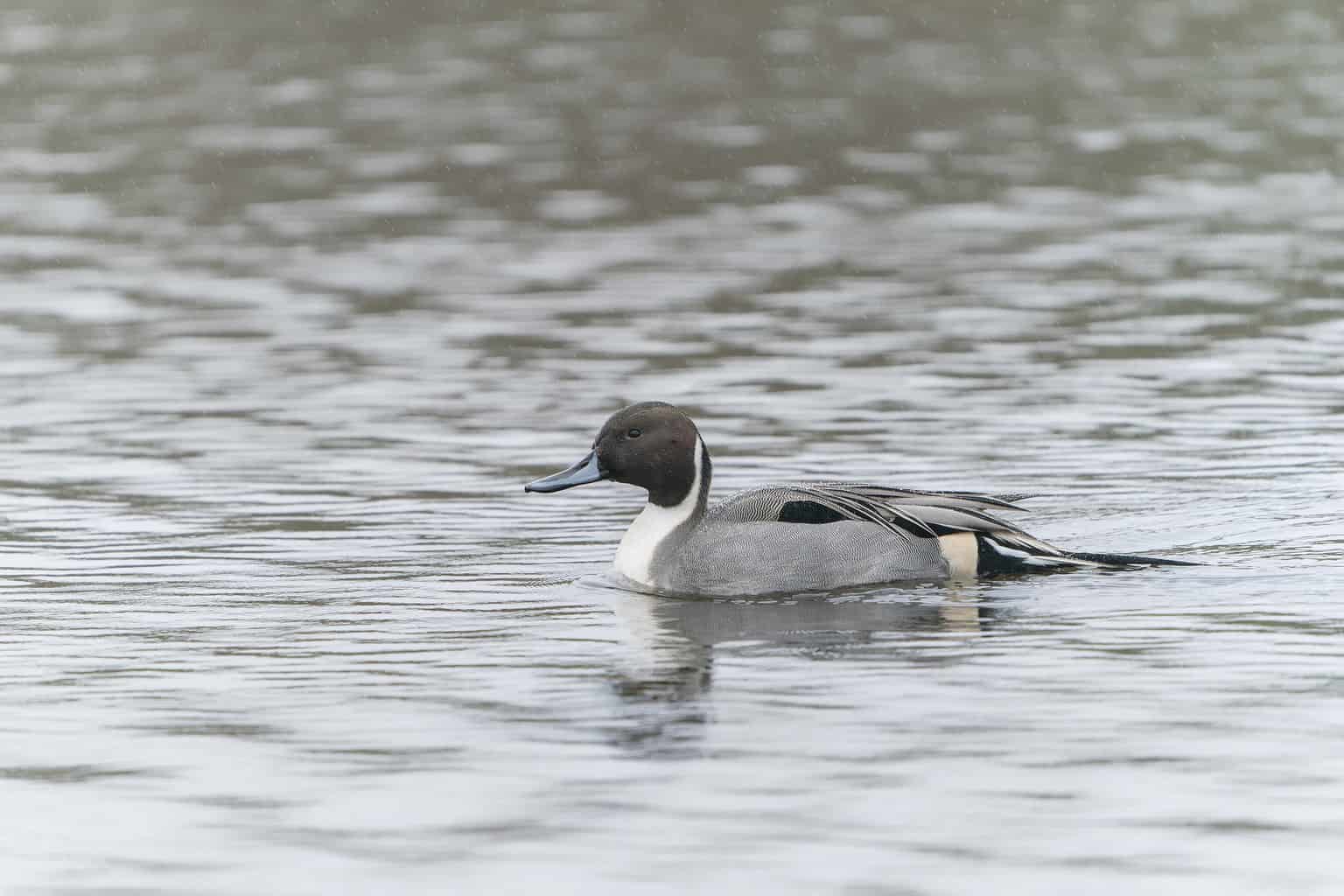
- Anas acuta
- Length: 20 – 26 in (51 – 66 cm)
- Weight: 36.33 oz (1030 g)
- Wingspan: 29 – 35 in (74 – 89 cm)
Whether or not you will see a Northern Pintail in California is dependent upon where you are in the state. If you live along the North Coast, in Southern California, or in the Dessert, your best bet is in the winter. They migrate through the Central Valley but don’t stick around. They live year-round in the Shasta Cascades and on the Central Coast.
Northern Pintails are fast flyers, clocking up to 48 miles per hour. They have long, pointed tails during the breeding season. In the winter, their tail feathers get shorter thanks to molting, but those long feathers grow back for the breeding season.
Males have brown heads with a white stripe on the sides of their heads.Their bodies are black and gray, and they have white on their backs. They also have an iridescent green speculum.
The pattern on a female’s light brown body is intricate, with dark brown scales.
Their long necks allow them to reach deeper under the water, even as they are just dabbling ducks. This makes them more comfortable in deeper waters than most other dabblers.
Northern Shoveler (Dabbling Duck)

- Spatula clypeata
- Length: 17.3 – 20.1 in (44 – 51 cm)
- Weight: 14.1 – 28.9 oz (400 – 820 g)
- Wingspan: 27.2 – 33.1 in (69 – 84 cm)
Northern Shovelers are common winter residents of California. A small sliver of territory to the west of the Central Valley is also home to year-round Northern Shovelers.
Male Northern Shovelers have green heads, somewhat like a Mallard’s head. However, they have very thick, broad, strong bills that make them look unlike any other duck on this list. This bill is often described as spatula-shaped.
Males have a gray breast and brown sides, and a gorgeous iridescent green speculum.
Females have the same thick bill, but it is brown, not black. The female is mottled in brown with a blue shoulder patch.
Northern Shovelers live in large groups. Their preferred waters are shallow – even standing water in a flooded wetland is very hospitable to a Northern Shoveler population. They nest in the ground and will defecate on their eggs to protect them from predators.
Red-Breasted Merganser (Diving Duck)
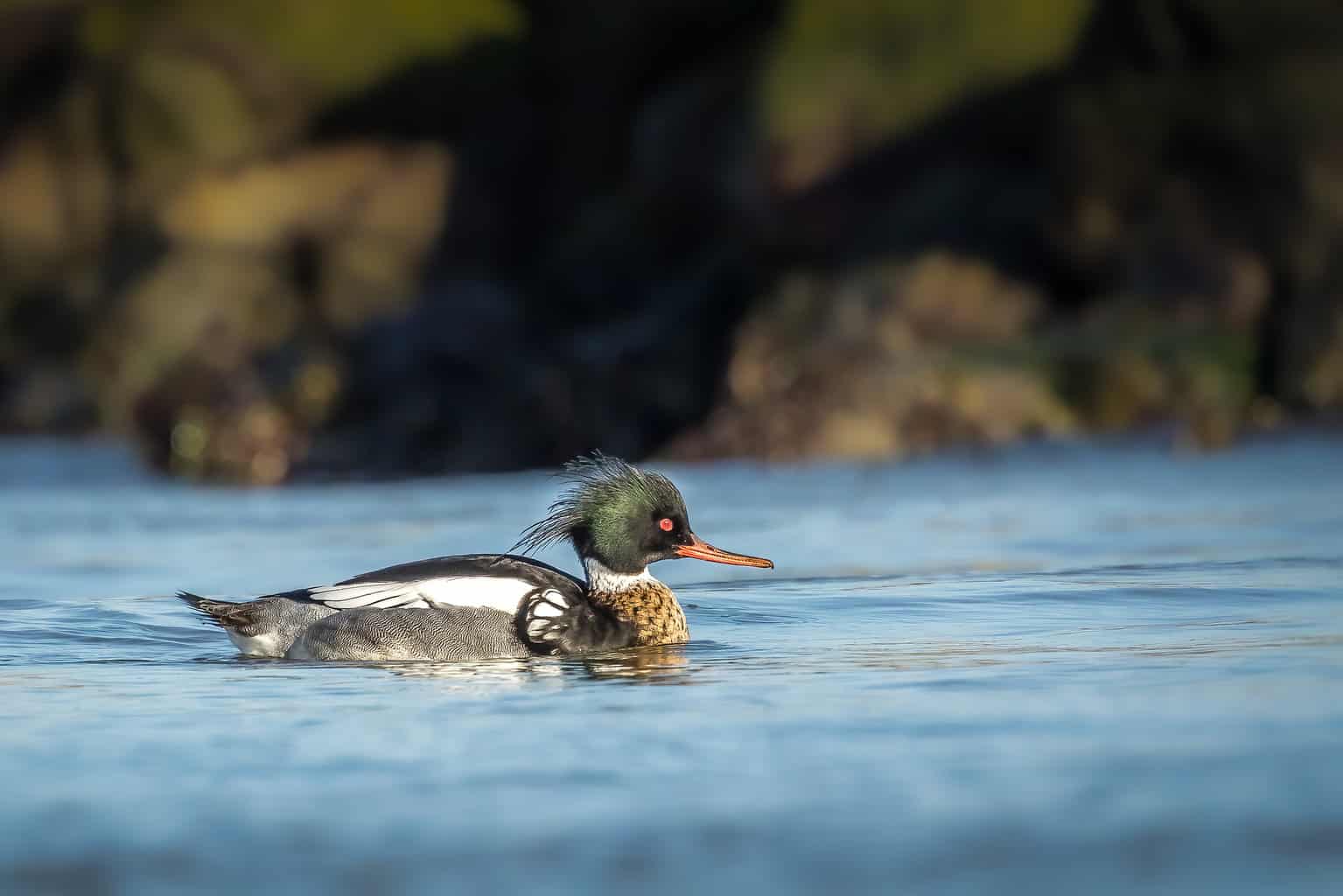
- Mergus serrator
- Length: 16 – 26 in (41 – 66 cm)
- Weight: 47.61 oz (1349 g)
- Wingspan: 31 – 35 in (79 – 89 cm)
Red-Breasted Mergansers, like other mergansers, are mostly ocean-dwellers. They winter across Canada, including on the tundra, and then they migrate through the majority of the US to spend the winter along all of the coasts: Pacific, Atlantic, and Gulf.
You’ll see them on their migratory journey in most of California, and then they will stay put on the coast for the winter.
The male Red-Breasted Merganser has a dramatic, attention-grabbing crest on the top of his iridescent (almost black) green head. His eyes are red, and his bill is long, orange, and serrated. He has a thick white ring on his neck and a brownish-red chest.
The female has a crest, but it matches her cinnamon-brown head. Her throat is white, and her body is mostly gray.
Redhead (Diving Duck)
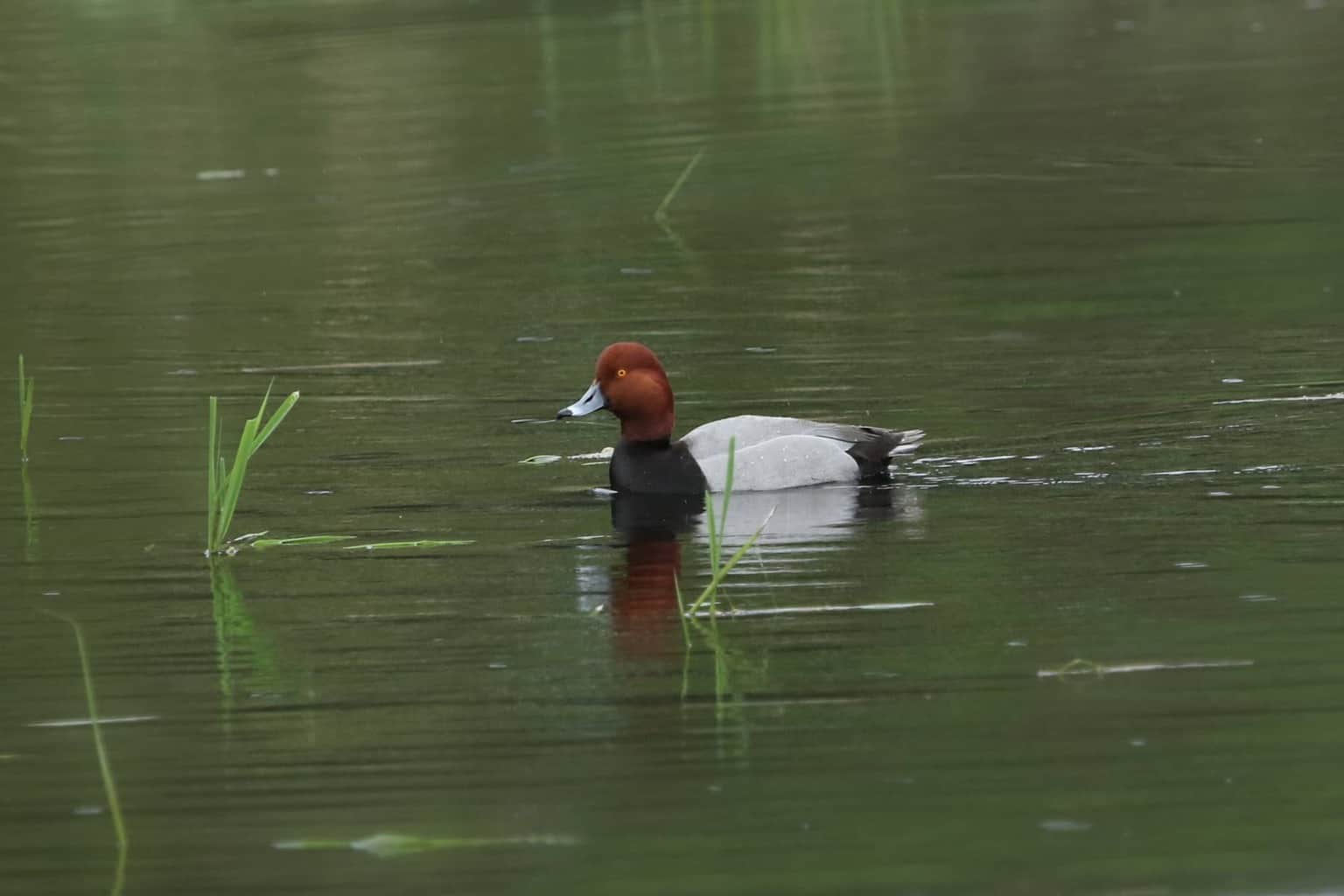
- Aythya americana
- Length: 18 -22 in (46 – 56 cm)
- Weight: 43.03 oz (1219 g)
- Wingspan: 29 – 35 in (74 – 89 cm)
California’s regions see Redhead Ducks at different times of the year. They breed in the Shasta Cascades, migrate along the North Coast, and live year-round in the Gold Country, Sierra Nevadas, and parts of the San Joaquin Valley. Along the rest of the coast, they are winter-only residents.
Redheads are usually pretty easy to identify. Males have dark, coppery red heads, a dark black chest, and a gray back. He has a grayish or blueish bill with a black tip.
Female Redheads, on the other hand, are brown. They have very few distinctive markings or patterns, and their bills look just like the male’s bills.
Redheads are occasional brood parasites. That means that they will lay eggs in other ducks’ nests to increase their chances of reproductive success. They can create more ducklings than they have to take care of themselves.
Ring-Necked Duck (Diving Duck)
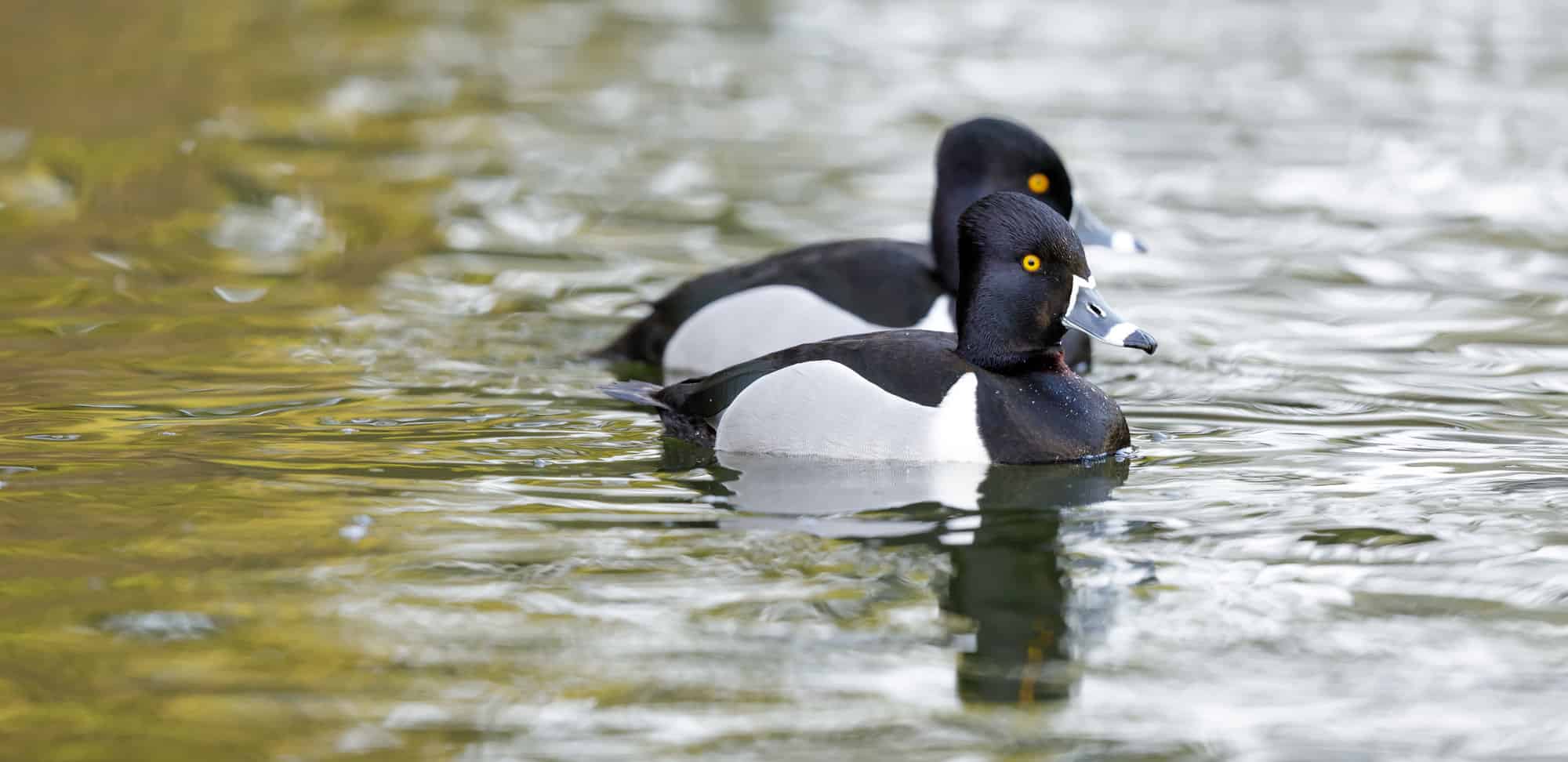
- Aythya collaris
- Length: 14 – 18 in (36 – 46 cm)
- Weight: 32.09 oz (909 g)
- Wingspan: 24 – 30 in (61 – 76 cm)
Ring-Necked Ducks are mostly present during the winter in California. Some will live year-round in the Shasta Cascades. (If that sounds familiar, you’re right – the Shasta Cascades seem to have the most duck activity in the state of California!)
Ring-Necked Ducks are poorly named. The copper ring around the male’s neck is nearly impossible to see, even up close. However, they do have a white ring around the base of the bill, and a white band near the bill’s tip.
Male Ring-Necked Ducks have white undersides and a black chest, back, and head. They have yellow eyes.
Females are brown-bodied with a gray face, no ring around the base of the bill, and a thin white eyering.
Their winter territory includes small lakes and marshes, agricultural fields and cattle ponds, and beaver ponds.
Ruddy Duck (Diving Duck)
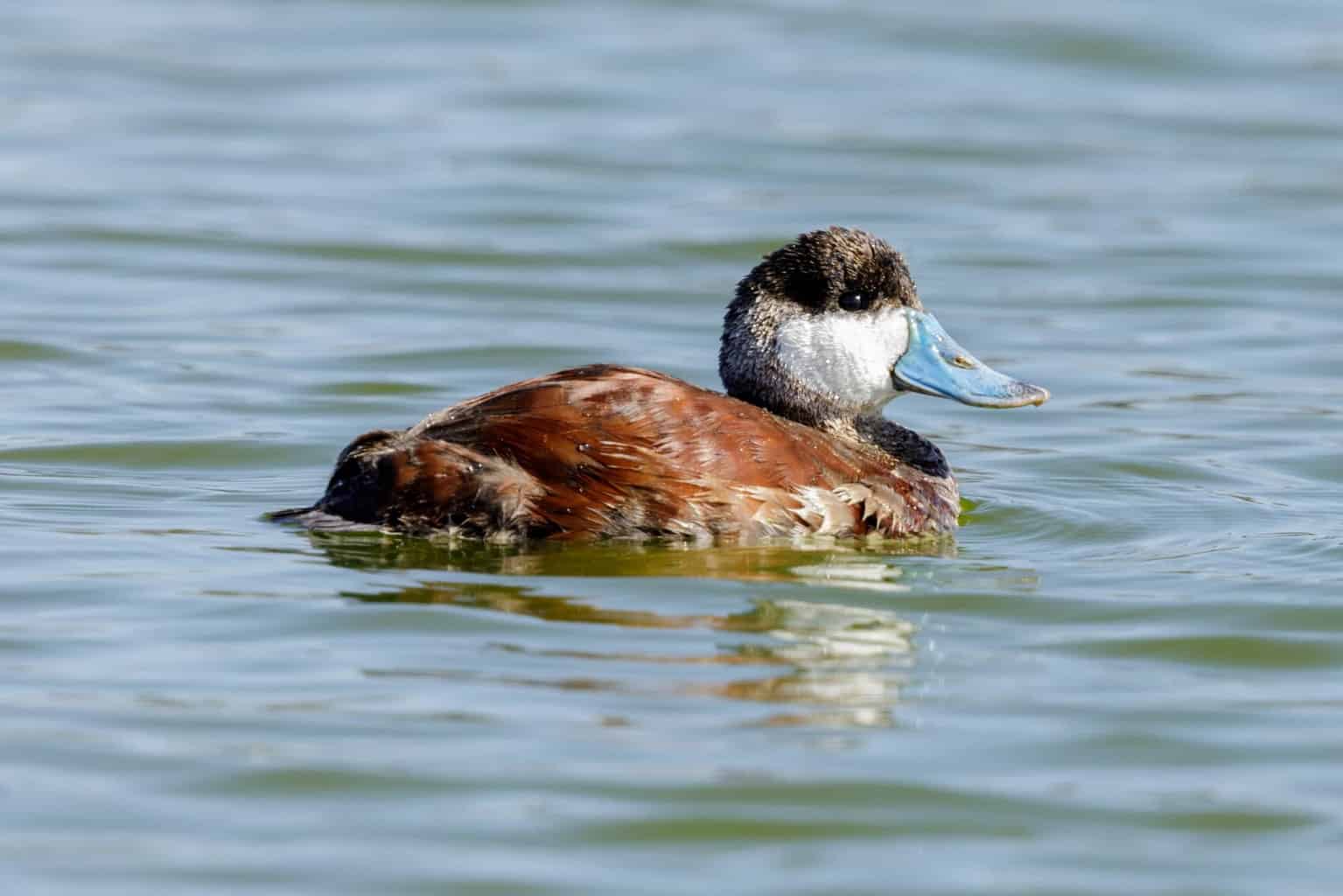
- Oxyura jamaicensis
- Length: 14 – 16 in (35.56 – 40.64 cm)
- Weight: 28.04 oz (795 g)
- Wingspan: 21 – 24 in (53 – 61 cm)
Ruddy Ducks are year-round residents of the Shasta Cascades and the southern half of California, and winter residents of the northern half.
Male Ruddy Ducks are a dull gray color in the winter. During the breeding season, they are dark reddish-brown. They have a black cap, a large white cheek patch, and a broad, blue bill.
Females are brown-bodied with a brown cap and a cheek patch that is pale gray. She has a broad bill that is black, not blue.
Ruddy Ducks prefer freshwater sources in the summer, like marshes and ponds. During the winter, they like shallow bays and sheltered coastal estuaries.
They are occasional brood parasites, like the Redhead.
Surf Scoter (Diving Duck)
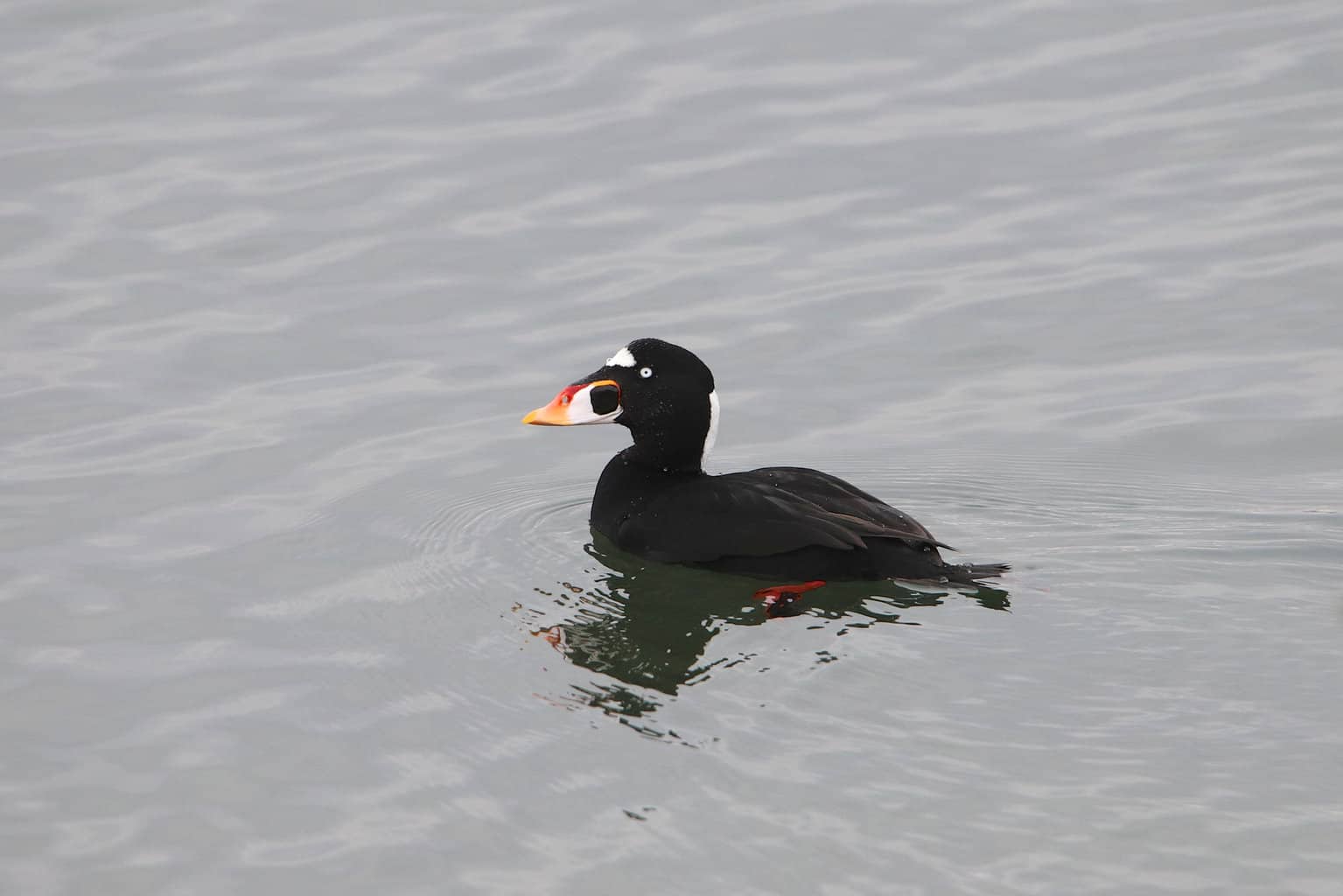
- Melanitta perspicillata
- Length: 17 – 21 in (43 – 53 cm)
- Weight: 35.27 oz (1000 g)
- Wingspan: 30 – 36 in (76 – 91 cm)
Surf Scoters are found along all of the California coast during the winter. They live off the open water in the winter, in bays and estuaries.
The male Surf Scoter’s bill gives him away: big, orange, red, white, and yellow, with a big black spot at the base. His eyes are white, and the rest of his body is mostly black. He does have two white spots: one above his bill, and another behind his neck.
Females are dark gray and have a white patch on the back of their necks. They have a large bill without the same color variations.
Surf Scoters eat freshwater crustaceans, fish, worms, echinoderms, and aquatic insects. They don’t travel inland, but they also don’t venture far into the open waters.
Tufted Duck (Diving Duck)
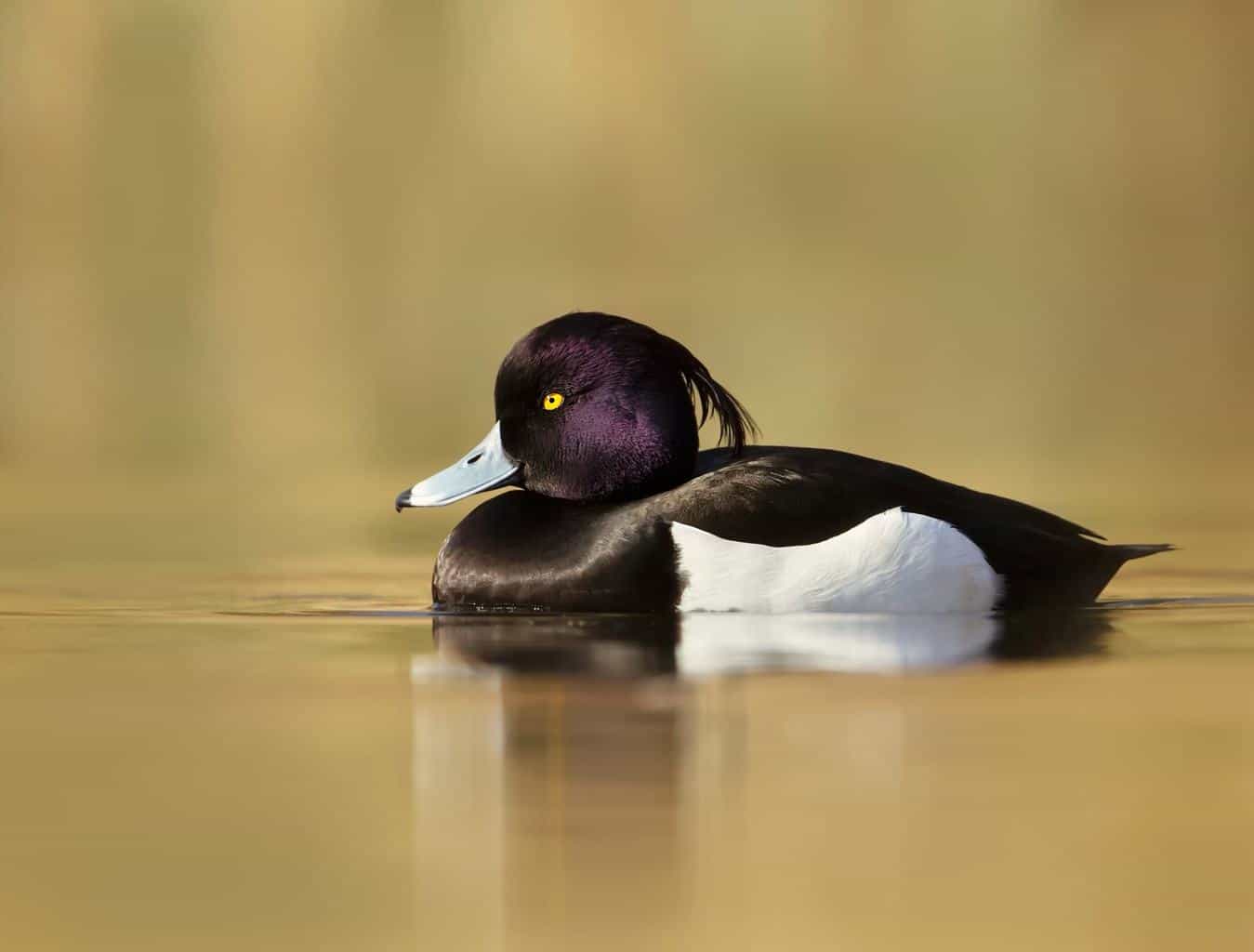
- Aythya fuligula
- Length: 16 – 18 in. (40.64 – 45.72 cm)
- Weight: 1.5 lb (24 oz)
- Wingspan: 25.5 – 28.3 in (65 – 72 cm)
Tufted Ducks have been spotted throughout California, although they are not frequent visitors to the state. They are European ducks who occasionally appear in North America as vagrants.
Males have bright white flanks and are otherwise white. They have a long crest that flops downward at the base of the head. Females are dark brown, and their crest is shorter.
Males and females alike have a white stripe down their wings.
They are nighttime foragers who sleep for most of the day. If they are spotted in North America, it is usually among a group of Scaup.
White-Winged Scoter (Diving Duck)
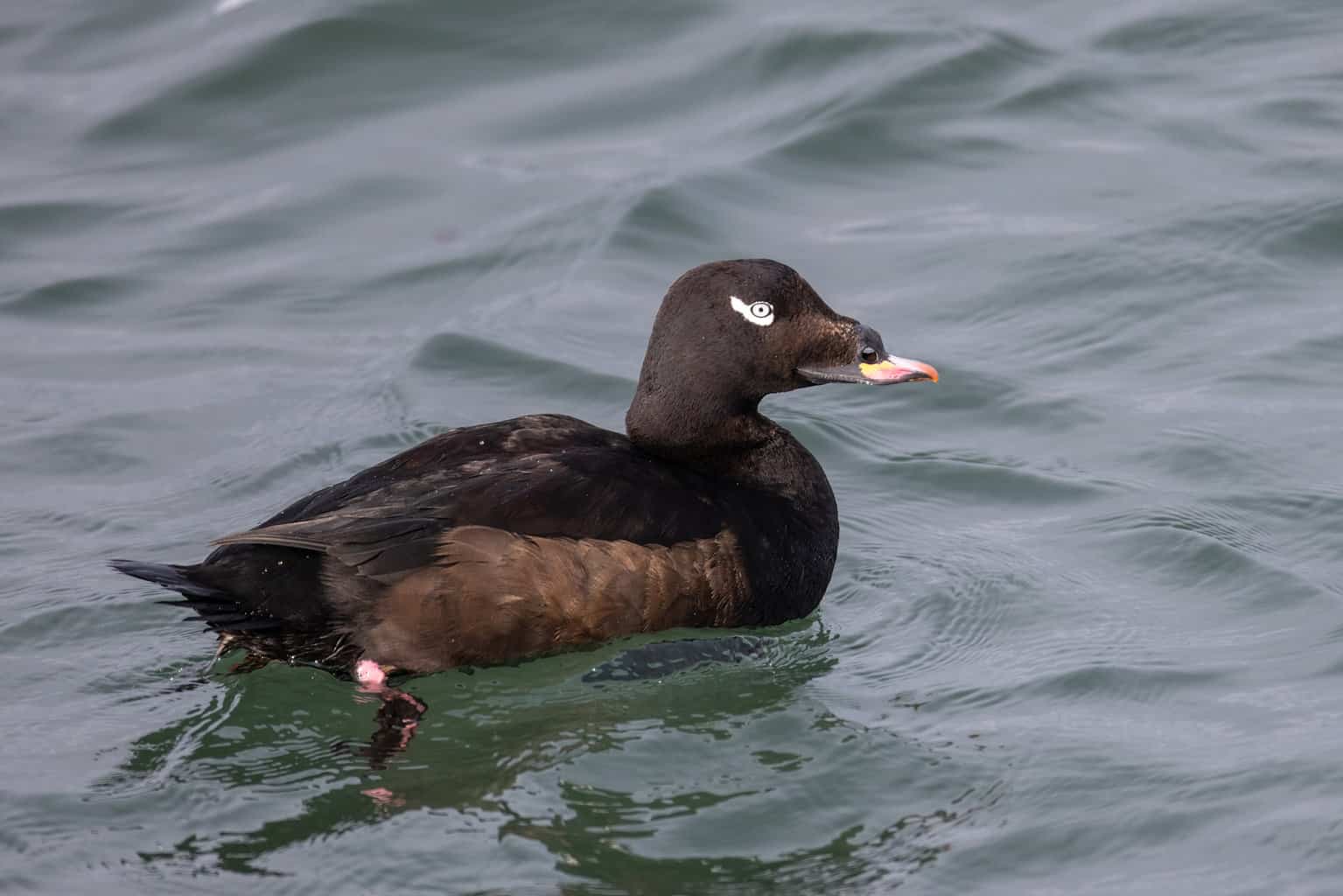
- Melanitta deglandi
- Length: 19 – 24 in (48 – 61 cm)
- Weight: 62.4 oz (1768 g)
- Wingspan: 33 – 41 in (84 – 104 cm)
For much of the year, White-Winged Scoters are mostly found in Canada, especially in the tundra. However, they do spend the winter along the Pacific and Atlantic coasts. This means that you can find them along the shallow coastal waters of California during the winter.
White-Winged Scoter males and females are very similar to one another in appearance. Males are dark black, and they have a white comma-shaped mark over their eyes. They also have a white stripe on their wings.
The female is dark brown, and she has a white stripe on her wings. She also has white patches on her face – one on either side of her eyes.
Males and females alike have a bulbous bill.
White-Winged Scoters flock in large groups during the winter. They also practice natal philopatry, which means that they nest in the same area where they were hatched as ducklings.
Wood Duck (Dabbling Duck)
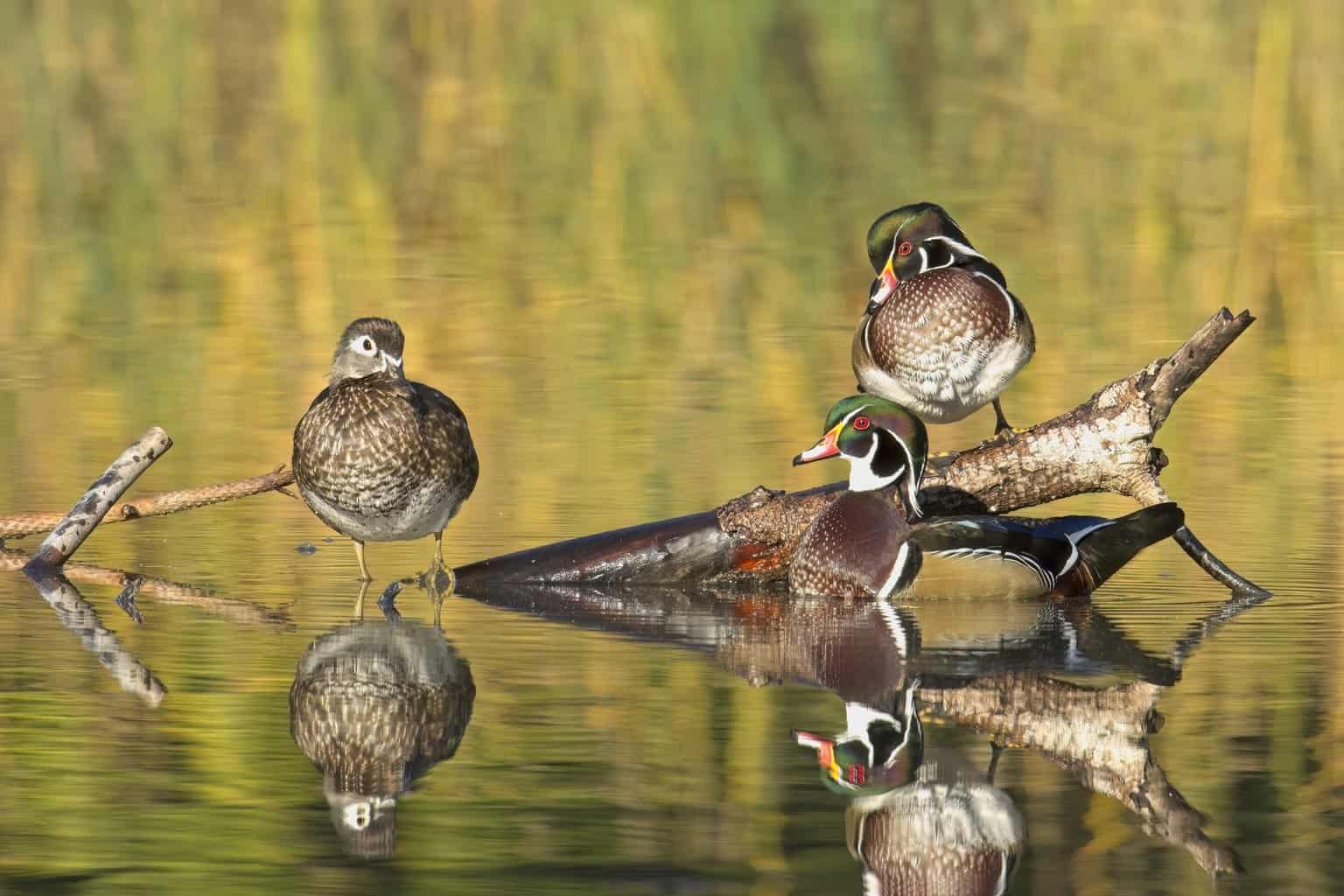
- Aix sponsa
- Length: 18.5 – 21.3 in (47 – 54 cm)
- Weight: 16.0 – 30.4 oz (454 – 862 g)
- Wingspan: 26.0 – 28.7 in (66 – 73 cm)
Wood Ducks live year-round in the coastal regions of northern California. In the Central Valley, they are winter-only residents. Meanwhile, they avoid the Shasta Cascades and the Dessert altogether.
Male Wood Ducks have a gorgeous iridescent green head that has a long, downward-sloping crest at the base. The male’s breast is chestnut-brown, and his sides are buff. He has white markings on his body.
Females are gray-headed and brown-bodied. They have a blue speculum.
Wood Ducks nest in cavities, very close to the water. Their nests are high above the ground – up to 60 feet!
Learning to Spot Ducks in California
Ducks are plentiful in California’s many waterways. As you can see from this list, some of the best places to see ducks in the state are in the coastal bays of the Pacific Ocean and in the Shasta Cascades. Upstate California is home to many year-round ducks.
When learning to identify ducks, take careful note of the following features:
- Shape/silhouette
- Colors
- Patterns (stripes, speckles, patches, etc)
- Behaviors (diving, dabbling, fighting, etc)
- Location/habitat
- Season
If you can spot a nest, ducklings, what the duck is eating, or other interesting observations, that can be helpful, too!
For more birding tips in California, check out our Bird Guide for the state!

